Growing stronger
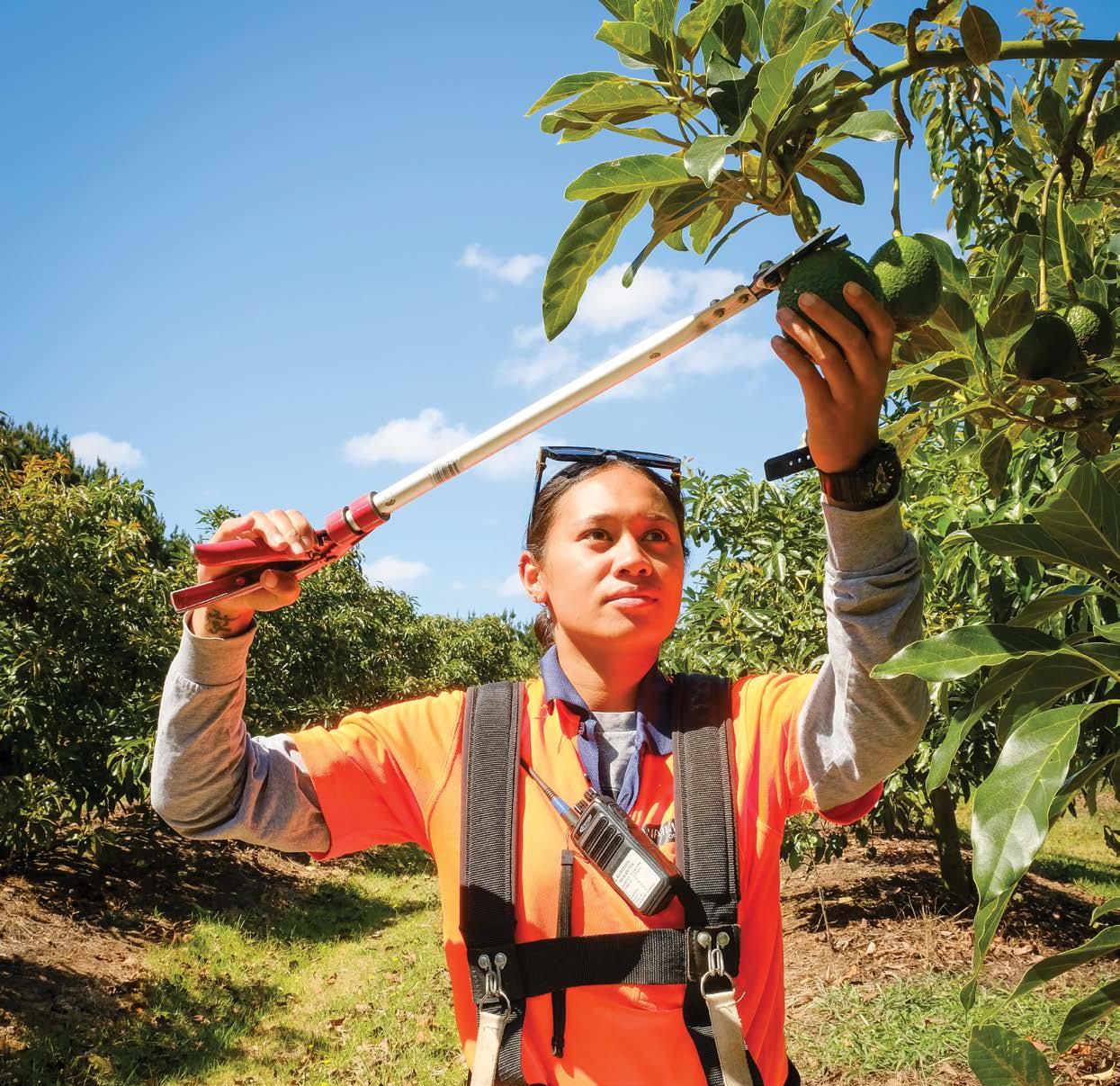
14 Decarbonising heavy transport
41 Northland’s tropical shift
49 Wood, steel or concrete supports
Page 35 CLIMATE MITIGATION ADAPTATION& SPECIAL VOL 97 | NO 02 | MARCH 2024
issue
In this

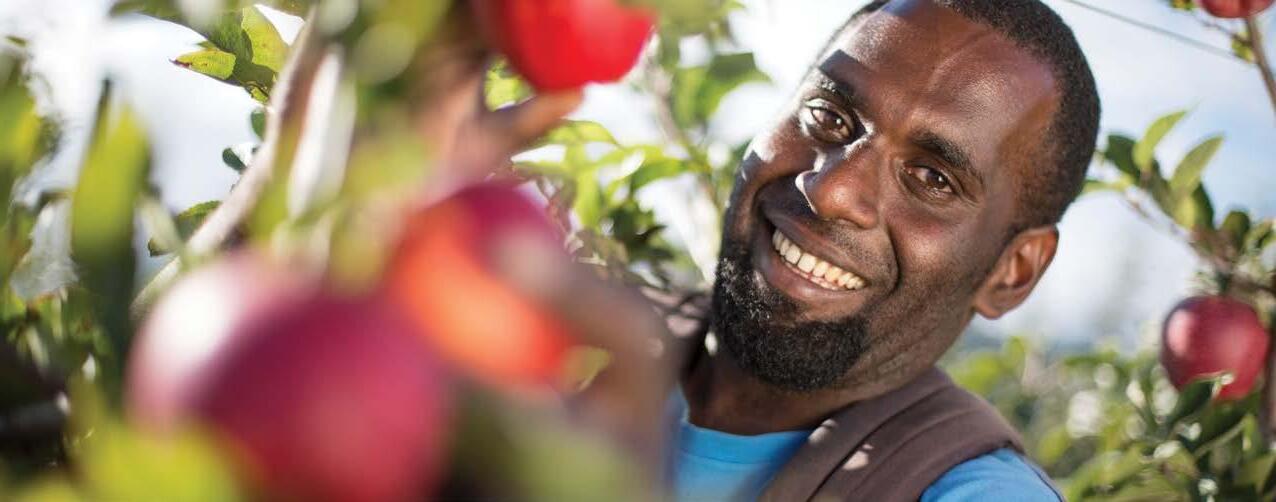
Making travel easy for RSE employers and workers
RSE Travel powered by World Travellers Motueka are your professional travel provider with a team of highly experienced staff members, who consistently provide outstanding service to New Zealand businesses that require recognised seasonal employees.
Travel For RSE Workers
What we do...
We currently look after 130 employers and 12,000+ RSE workers with a strategic partnership with NZEE and are keen to expand our valued client base throughout the country, to ensure other businesses have access to our special RSE fares and booking conditions with a number of airlines.
This will provide those requiring seasonal workers the opportunity to receive certain benefits they might otherwise miss out on.
With technology these days, we can effectively manage travel accounts from any location and our customers are spread throughout the length and breadth of the country.
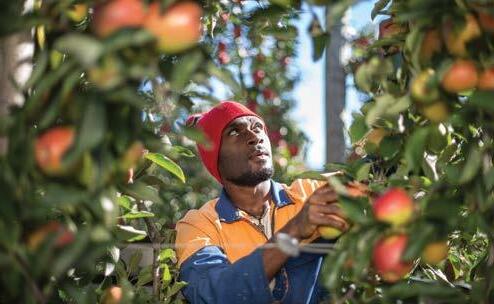
RSE Travel Management Tool: TRAVERSE

All your info in one place...
Spend less time searching through your old emails for information, reduce the time you dedicate to reading and composing emails to confirm booking details, and minimise the uncertainty regarding the status of each booking and any outstanding tasks.
All this information is available on a single screen or dashboard for your convenience in our custom-built travel management platform, designed specifically for RSE businesses.
Find out more
Get in touch...
For further information on our award-winning service, full suite of offerings and how RSE Travel can streamline your seasonal employee travel requirements, please check out our website, or give Managing Director, Phil Harris a call on 027 548 1366 for a free, no-obligation chat in confidence. Or, you may prefer to reach out to him on email at phil@wtmot.co.nz
www.rsetravel.nz
IMAGE:
©Golden Bay Fruit
IMAGE: ©Golden Bay Fruit




Contents
Up Front
2 President’s Word: Environment before the economy?
4 The Chief Executive: Stronger by working together
6 Advocating for grower-friendly climate settings
Your Industry
9 Looking to the future: a year after Cyclone Gabrielle
14 Decarbonising heavy transport to market
18 Decarbonising with electric machinery
22 Peacharines flourish in Mangaweka microclimate
25 Crop suitability changes with the climate
28 GMOs and new breeding techniques
32 Adaptation key for Northland’s horticulture
35 Growing at the top of the country
40 Northland persimmons feel winds of change
41 Tropical fruit potential in Northland
44 Climate change trigger for sustainable, resilient land use
46 A far better season for most
47 Officials experience growers’ passion, pride and pain
48 It’s your industry and your vote
Technical
49 Building sustainability into orchard systems
54 Adapting New Zealand’s biosecurity system
56 Northland’s changing climate

What’s New
A regular advertorial section of new products and services. This publication does not endorse the products or services featured here.
58 Genesis strengthens their commitment to Kiwi growers
59 World Travellers Motueka announce launch of RSE Travel Management portal
60 Testing for healthy avocado crops
Final Pick
61 Climate adaptation never more pressing
On the Cover
Crop lead Roimata Pio working among Waimarama Orchards’ 16,200 avocado trees in Northland, see page 35
MARCH 2024 9 41 40 22 The ORCHARDIST : MARCH 2024 1
Environment before the economy?
Barry O’Neil : HortNZ president
Over the Christmas break I read a few books, as one does, and one of these was written by a couple of former veterinary colleagues about their lifetime in country veterinary practice. Lots of good humorous stories and yarns as expected, but one thing that confronted me somewhat was the final chapter where they reflected on their long and fruitful careers and one made the statement:

“I feel strongly the need to leave our world as good as we found it, in sound environmental and economic health, but in that order, for future generations.”
“But in that order” has been a contentious position since I have been in growing, and while many of us might want this to be the case, unfortunately we do not always understand what we can and should be doing to achieve this. What are the acceptable trade-offs between environmental health and economic health and how should we be achieving balance in these?
This month’s magazine looks at climate change, and without doubt how we leave our land in as sound environmental and economic health as when we took it over is not an easy task in this context; but it’s a challenge that we need to face and not kick the can further down the proverbial road.
There are two aspects to this:
• Mitigating the impacts of our economic activities on the atmosphere, climate, water and environment to reduce degradation.
• Adapting to climate change by changing how and what we do to minimise risk to the environment, economy and people from future extreme weather events. How much can we afford to change; versus how much can we afford not to change is the dilemma!
The problem seems to boil down to this conundrum: If we change what we are doing now as we are being asked, then we will lose productivity and then we won’t be economically viable. Another catch is that some are suggesting we should embrace a new definition of economic viability, meaning a future that is potentially very different from today’s world.
Not surprisingly, the European Union has just wound back its climate change goals as they apply to farming, as a result of huge protests from Europe’s farmers forcing the politicians to reconsider what farming can actually manage if they are still going to survive and be able to produce enough food to feed Europe’s people. And in New Zealand when input costs have gone through the roof while productivity has been impacted by weather events, yet prices for our products have stayed static or reduced, there are similar concerns and frustrations.
It’s no wonder that farmers and growers have really struggled with what they need to do. Even those who fully understand and accept that the climate is changing due to mankind’s activities, do not yet understand what can be changed that won’t seriously impact on productivity and therefore profitability.
This is a dilemma that currently we each must resolve. We must each make our own decision about what we can and will change, and for now what we won’t be able to change until new tools come along, in order to remain economically viable. I am encouraged to see many growers changing what they are doing, little steps in some cases, but it is the start of the journey we all must make. We are practical people, and there are lots of things that can be done once we put our minds to it and our efforts towards it. Riparian and gully plantings, monitoring soil nitrogen to only use what is needed, and using more sophisticated slower release fertilisers, moving away from hard chemicals to softer options including biologicals, covered cropping, better soil management, more efficient use of machinery reducing diesel use, moving to solar power for packhouses and introducing electric vehicles are just some of the initiatives that are happening increasingly with growers, and that are making a difference.
2 The ORCHARDIST : MARCH 2024 PRESIDENT’S WORD
Growers are researching and trialling new and better ways of growing, such as in my industry where a group of progressive kiwifruit growers have only been using 30kg of nitrogen, and without any significant impact on productivity. They are trying this because they know we have to change, and importantly they are sharing their findings and knowledge so others can understand and hopefully follow. We know that technology will advance and give us more tools ‘tomorrow’ but that shouldn’t stop us acting on what we can do today. Where He Waka Eke Noa will go now with this new government we still don’t know, but what we do know is that we as growers can get on and achieve what HWEN was trying to achieve anyway, without the need for a one-size-fits-all regulatory approach.
We also need to look at the strong interconnection of people and nature fundamental to the Māori world view and the view of many other cultures around the world. Ko au Te Taiao, ko Te Taiao ko au (I am nature, and nature is me). We all share this connection with nature (te Taiao) each in our own way, and know that when nature thrives, we all thrive.
Another very important part of our response to a changing climate is adaptation, as we can’t just mitigate with the extreme weather events we are already experiencing which are making growing very difficult now, let alone tomorrow!
We are strongly advocating for adaptation measures that will enable growing on flood plains, where much of our growing happens. I will leave to others the argument whether people should be able to live in these areas, but one thing that I am certain of is that we need to be able to still use these areas for growing.
But to do this we need flood protection systems that work. These systems need to be dedicated for flood protection, not also for other uses such as conservation, so that a bulldozer can clean out the buildup of silt and gravel regularly, so the banks can be reinforced and if needed made higher. And the win-win to me is water storage at the start of the river in order to control water volumes in high rainfall situations, but also provide water in times of drought. But more on water storage in next month’s magazines!
Finally all this needs to be underpinned by science, so we need to seek and invest in research efforts to help us find solutions to how we can reduce our emissions to meet climate change goals. This includes our plant breeders being supported to breed plants more resilient to changes in climate, and to the pests and pathogens that go with a changing climate.
Horticulture New Zealand is actively lobbying and advocating for policy settings that support sensible climate change mitigation, along with robust approaches to provide for climate adaptation. The two must go together, and in doing so we can achieve sound environmental outcomes with the land being able to economically support future generations of growers.
Kia kaha.
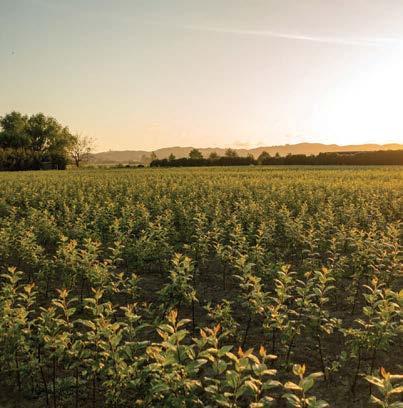
Visit our new website! We are thrilled to bring the Genesis story to life through the launch of our new website. Visit the website today and join our journey of enabling growers to be world-leading. www.gnl.nz Key features: Our story Fruit Varieties Available rootstocks Order enquiry form Meet the team Looking for trees this year? Don’t hang about, limited stock available including Rockit™, Envy™ and Dazzle™ sales@gnl.nz 021 827 831
THE CHIEF EXECUTIVE
Stronger by working together
The Horticulture New Zealand team has been on the road over the last few weeks meeting growers as part of a national roadshow.
Nadine Tunley : HortNZ chief executive
Engaging with growers is always a real highlight of my job. As the leader of an organisation dedicated to advocating for and representing the interests of over 4200 commercial fruit and vegetable growers, I see examples every day of the hard work shown by the thousands of people working in the horticulture sector. Every grower I encounter demonstrates a profound commitment to stewardship of the land and doing the best under what is often really trying circumstances.
We all know New Zealand is fortunate to possess ideal growing conditions and fertile soil, but it takes real perseverance and resilience for growers to cultivate nutritious and sustainable food for our nation and the world.
Among the regions we have visited so far has been Northland, which has a significant horticulture presence. Horticulture and fruit growing accounted for 12.5 percent of the overall value of Northland’s exports in 2022.
Hawke’s Bay, Tairāwhiti Gisborne, Bay of Plenty, Wairarapa and northern Manawatū.
For some growers, the rebuild and renewal process will take many years and the investment required to enable these regions to once again thrive will be significant. Scientists tell us that climate change will increase the frequency and severity of these adverse weather events so we need to take steps to mitigate or reduce the damage.

The HortNZ team up at Northland Field Days said it was great to see growers out in force – hopefully some of you were able to drop by our stand.
Northland was just one of the areas hit hard by Cyclone Gabrielle, which also wreaked a path of devastation in
This means taking a whole of catchment approach to flood protection and water use. It’s also critical highly productive land is protected for primary production and that growing fruit and vegetables is the first priority for land-use in these valuable areas.
This approach would also see more bush on hill country, fewer houses in flood prone valleys, and more water storage.
New Zealand needs to ensure a resilient supply of fruit and vegetables through permissive planning that allows geographic variation in growing areas.
We also require policy and planning support for climate adaptive growing, including covered cropping.
Acting Editor:
John Gauldie
Email: editor@hortnz.co.nz
Advertising Manager:
Jackie Enright
Ph: 04 494 9986
Mobile: 0274 489 913
Email: jackie.enright@hortnz.co.nz
Design:
Scenario.co.nz
Ph: 04 385 9766
Email: joy@scenario.co.nz
Subscriptions:
Email: info@hortnz.co.nz
This publication uses vegetable based inks and environmentally responsible paper produced from Forest Stewardship Council® (FSC®) certified, Mixed Source pulp from Responsible Sources.
Paper produced using Elemental Chlorine Free (ECF) and manufactured under the strict ISO14001 Environmental Management System.
The wrapper we use is 100% recyclable, it is LDPE 4 (Low Density Polyethylene) Soft Plastic and meets the required standards. For further information refer to: https://www.recycling.kiwi.nz/our-story
The nation needs to maintain effective flood protection systems in food producing areas. Flood-protection infrastructure must be continuously strengthened, and silt and shingle debris removed from flood channels. During the various meetings with growers, we have been sharing HortNZ’s priorities for the next few years, hearing their views and ideas and providing an update on our various programmes such as A Lighter Touch, Growing Change and the horticulture sector Aotearoa Horticulture Action Plan.
We along with some product groups have also been providing information on our upcoming levy referendum where growers will get the chance to have their say on the future of HortNZ. If you haven’t been able to attend a grower meeting, we would still like your feedback. Growers can do this by submitting written comments on our Growing Together feedback form which you can find on our website www.hortnz.co.nz, by calling us on 0508 467 869 or emailing us at info@hortnz.co.nz
In March 2025, HortNZ’s Commodity Levy Order, which funds the work we do, will expire. We will be seeking grower support for the continued funding of the organisation.
Collective investment by growers provides the size and scale needed to achieve things that no individual grower can achieve alone
HortNZ supports growers to make more informed decisions, providing them with tools and services to enhance their productivity and profitability.
We advocate on growers’ behalf to try and achieve sound and sensible policy settings including around climate change and freshwater so growers can provide a reliable and resilient supply of fresh vegetables and fruit for all New Zealanders.
I believe the horticulture sector is certainly stronger by working together. Collective investment by growers provides the size and scale needed to achieve things that no individual grower can achieve alone.
HortNZ is proud of our achievements for growers over the past six years – notably the strong advocacy during the various COVID-19 lockdowns that enabled growers to continue to harvest crops and supply domestic and export markets and quarantine-free travel for RSE workers, leading the cyclone recovery and securing policy gains for the sector.
The next six years will be an important period for New Zealand’s growers and the country as a whole.
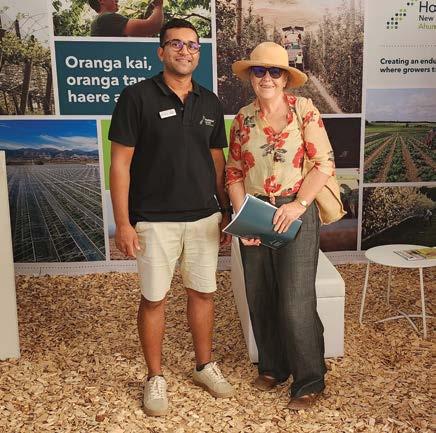
If growers vote to continue funding HortNZ, we will be pushing the case with government in key areas including water storage and allocation, ensuring the reliable supply of nutritious locally grown fresh vegetables and fruit, streamlining assurance processes, employment flexibility, removing current legislative barriers to businesses and providing certainty for Pacific workers and employers.
The sector is also poised to take advantage of some encouraging tailwinds in its favour.
In December, the Ministry for Primary Industries’ Situation and Outlook for Primary Industries report revealed a strong future for New Zealand horticulture with forecast export revenue rising to $8.19 billion by 2025.
The report showed the horticulture industry overtaking forestry to be the third largest earner of export revenue in the food and fibre sector by 2025.
Increased export prices are forecast over the coming years, supported by strong global demand and constrained global supply. Recovering crop yields in 2024 are expected to offset lower volumes for some crops, largely resulting from the tail end of weather-affected 2023 harvests.
In a positive development, the sector is also looking forward to New Zealand ratifying the free trade agreement with the European Union, particularly good news for our onion and kiwifruit sectors.
We want New Zealand to prosper by exporting our worldleading fruit and vegetables to millions of customers all over the world.
We are confident we can double farmgate revenue by 2035 in line with the Aotearoa Horticulture Action Plan. But we can’t do it alone.
We need the government to recognise and understand the importance of horticulture and create and maintain the conditions for our industry to thrive, and in doing so, lift the overall health, wellbeing and economy of New Zealand.
The ORCHARDIST : MARCH 2024 5 THE CHIEF EXECUTIVE
Grower Roslyn Norrie spoke with HortNZ’s Arjune Dahya at Northland Field Days
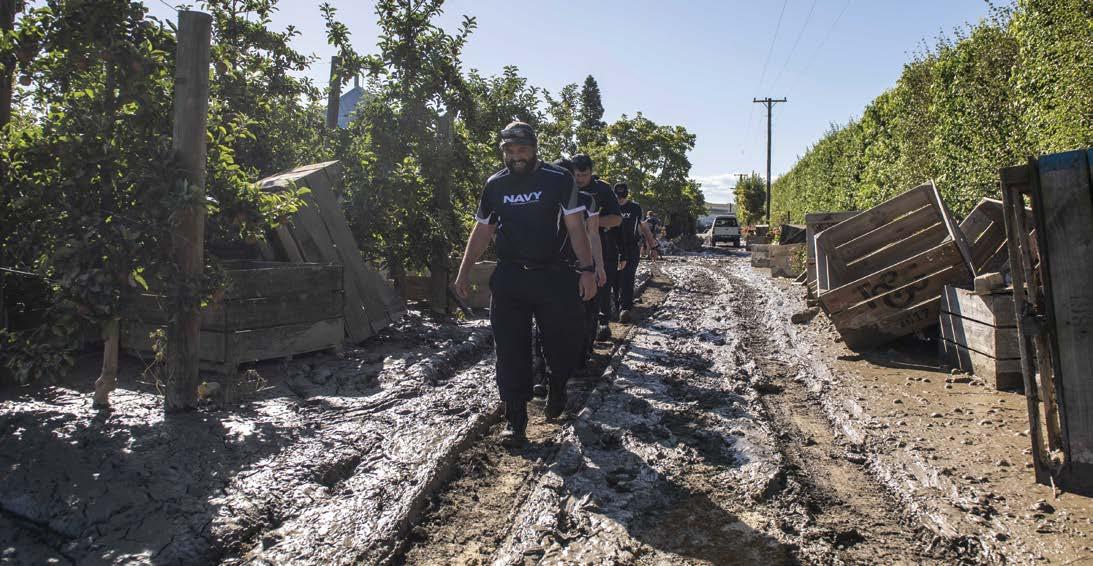
Advocating for grower-friendly climate settings
Strengthening our domestic food production is a form of climate change adaptation – ensuring we have a strong local food system that will feed New Zealanders when changing weather and extreme events disrupt horticulture in other parts of the world.
Michelle Sands : HortNZ general manager strategy and policy
The Horticulture New Zealand Environment Team has used this argument throughout our submissions in 2023 to stress that bolstering New Zealand horticulture is essential to preparing the country for climate change. We argued for regional resilience – geographic variation in growing operations, so if a severe weather event hits one region, there will still be fruit and vegetable production in other parts of the country to lessen the national impact. Strong central government direction is needed to direct regional and district councils to seek the same outcome.
In 2023, we first made this argument in our submission on the Natural and Built Environment Act, which, because of our advocacy, included a clause requiring the national planning framework to provide direction on “enabling supply of fresh fruit and vegetables”. Although this Act was recently repealed in December, we will seek similar direction in replacement legislation.
After Cyclone Gabrielle struck, the importance of horticulture for national climate adaptation came into stark relief. In our submission on the Ministerial Inquiry into
After Cyclone Gabrielle struck, the importance of horticulture for national climate adaptation came into stark relief. Photo courtesy of NZDF
CLIMATE SPECIAL 6 The ORCHARDIST : MARCH 2024 CLIMATE MITIGATION & ADAPTATION SPECIAL
Land Use in Gisborne and Wairoa, we called for climate adaptation to be at the heart of the rebuild conversation, as well as how to reduce the risk to food production from future flooding events.
Adapt
and
foster resilience and lower emissions, but in a manner that does not threaten food production
We highlighted the vulnerability of horticultural lands on the fertile soils of floodplains to the large weather events predicted to become more frequent. A full-catchment approach to risk management should be used, so that the ability to produce food on these lowlands is not compromised by the erosion from hill country.
In May, we wrote that increasing resilience should be a high priority in New Zealand’s approach to international climate negotiations, particularly for our Pacific neighbours who are invaluable partners in our food system. We called for adaptation measures to protect and enhance global food supply, including protecting elite soils and rehabilitating degraded ones to grow more food and sequester carbon.
We echoed the caution of the Paris Agreement which recognised the “fundamental priority of safeguarding food security” and noted the need to adapt, foster resilience and lower emissions in a manner that does not threaten food production. We also called for investment in science to support climate adaptive growing strategies and new resilient crop cultivars.
In November, we submitted on both the Environment Select Committee’s Inquiry into Climate Adaptation and Managed Retreat, which was created to inform the potential Climate Adaptation Act, and the proposed National Policy Statement for Natural Hazard Decision-making. In both of these submissions, we cautioned that urban risk assessment methodologies should not be applied to horticulture. Horticultural buildings and structures have a different designlife than urban buildings, and since people do not sleep in them, they carry less risk. Including horticulture in managed retreat requirements would be a risk to food security and lead to an inefficient use of highly productive land.
In these, and earlier submissions, we pointed out the importance of rural road networks to ensure fresh produce can still make it to people who need it in times of crisis. We also called for flood mitigations to prioritise protecting fruit and vegetable production.
We also called for investment in science to support climate adaptive growing strategies
We carried these arguments through in hearings on regional plans in Wellington and Otago, calling for an integrated approach to climate change mitigation and adaptation that recognises the importance of food production and protecting highly productive land from floods. In 2024, we will carry these arguments forward with the new government and in local plans to ensure climate risks to horticulture are recognised and mitigated without compromising the supply of fruits and vegetables.

1.95% interest | 30% deposit with 36 monthly payments. GST paid back in 3rd month. T&Cs apply. ORCHARD TRACTOR STOCKTAKE SALE P: Sales 022 573 8030 or 022 573 4910 E: sales@boptractors.co.nz | www.boptractors.co.nz LANDINI REX DT80GE $59,900 + GST The ORCHARDIST : MARCH 2024 7 CLIMATE MITIGATION & ADAPTATION SPECIAL
YOUR INDUSTRY
ACROSS THE SECTOR — ACROSS THE COUNTRY
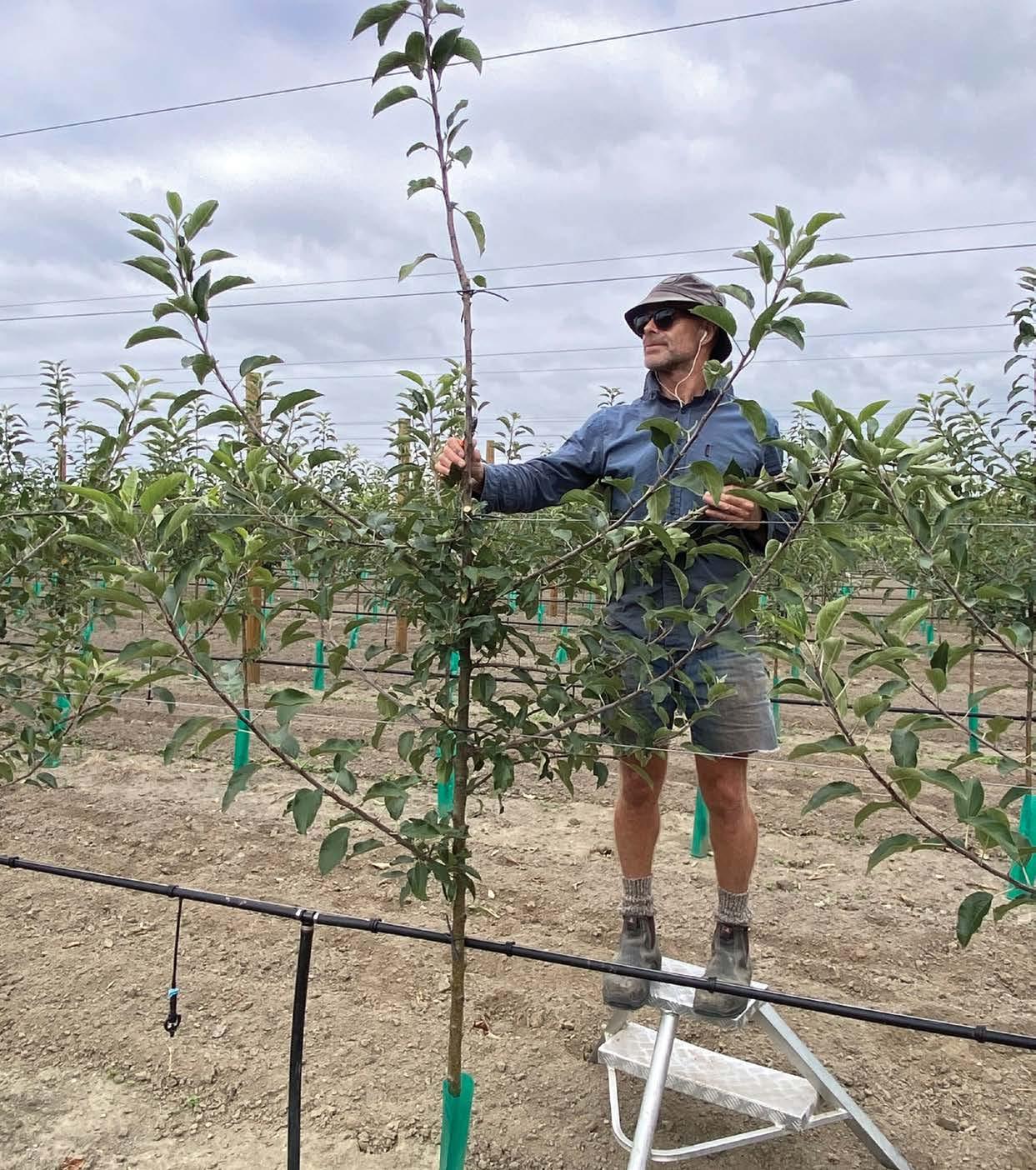

Looking to the future: a year after Cyclone Gabrielle
One year on from Cyclone Gabrielle, Hawke’s Bay growers are focussed on the future. It’s a mix of consolidating losses, resetting orchards for automation and hard work.
Bonnie Flaws
Due to “near perfect” growing conditions in the year that has followed, the apple crop is set to be 12 percent up on last year, rebounding from the damage unleashed by the storm just as harvest was starting in 2023. With an estimated export volume of 21.2 million boxes, the crop is also expected to have excellent eating qualities, size and colour, says NZ Apples and Pears chief executive Karen Morrish. As well as favourable conditions, hard graft has been at the core of the turnaround. “Growers work hard every season, but for those impacted by Cyclone Gabrielle, the past year has been tough and continues to be tough for those still recovering. Many growers had to dig their orchards out of silt, so it is amazing and surprising to see where we are today after where we were a year ago. Apple trees have proved to be resilient and so too are our growers,” she says.
Korokipo grower Mark Ericksen, whose flooded Waima Orchards featured on Country Calendar last year, is harvesting when I go out to meet him in early February. He had lost 75 percent of his apple crop and 100 percent of his kiwifruit crop in the storm. Due to the height of the floodwaters any fruit covered with water had to be dropped onto the ground. It was four to five metres, so everything not harvested at the time was contaminated. The home farm, which has been in the family for 100 years, was flooded and his parents were lucky to get out alive as torrents of fast-rising water surged through their old homestead. Mark and his wife Leah woke up to the surreal scenes below, despite their home being safe.
Waima Orchards’ surviving trees have proven resilient, partly thanks to the CG202 rootstock with tolerance to waterlogging with a strong GEMTM harvest completed in February. Photo by Bonnie Flaws. Opposite: Waima Orchards flood recovery manager Simon Kerr tree training 6-month-old CG202 JuGala trees
The ORCHARDIST : MARCH 2024 9 YOUR INDUSTRY
A TIMELINE OF RECOVERY

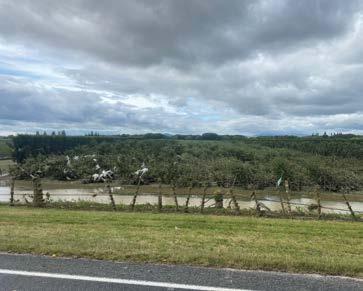
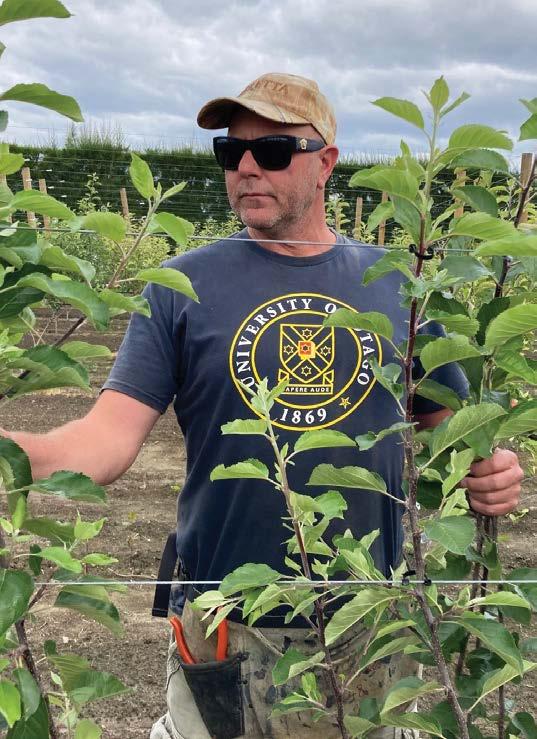
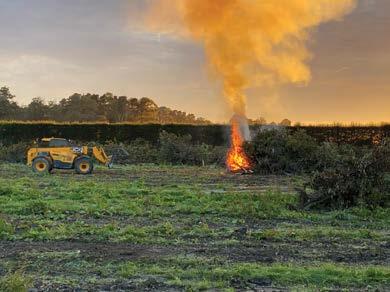
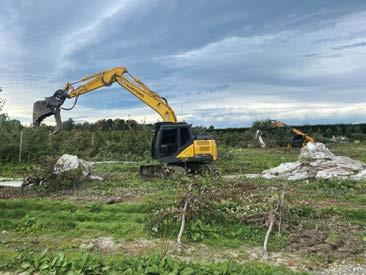
“No-one knew what was going on, there was no Civil Defence, no plans in place. We all rallied together and got mum and dad out. All of us along Korokipo Road took different ones under our wing to support each other. We were lucky to be living on the hills here… we were all like possums in the headlights.”
Mark lost 75 percent of his apple crop and 100 percent of his kiwifruit crop
But now, 12 months on the orchards are somewhat full to the brim with glorious fruit again where the teams are hard at work. He still has more replanting to do and there is still work to do on the drainage for his kiwifruit. Ironically all the structures supporting the kiwifruit were okay after the flood, but because the vines were moisture stressed for so long many of them have died.
Since 2005, Waima Orchards has been planting an apple rootstock (CG202) that is more tolerant to waterlogging due to its phytophthora resistance properties. In August 2023 they replanted the flood devastated blocks with RockitTM and Jugala on CG202 rootstocks.
Like many others, Waima Orchards is planting back with more intensive plantings for higher production, with narrower rows designed for electric platforms for pruning, and for the future of automated picking. The trees are trained to grow in a more simplified, linear architecture type of canopy.
At the peak of the 2023 harvest, trees are barely visible under four to five metres of floodwaters. As the floodwaters receded, the destruction was clear. Waima Orchards lost 75 percent of its apple crop and 100 percent of its kiwifruit crop
Pulling out and burning trees on a destroyed block
Waima Orchards’ Mark Ericksen says that local authorities need to address flood protection infrastructure urgently to prepare for future events. Photo by Bonnie Flaws
10 The ORCHARDIST : MARCH 2024 YOUR INDUSTRY

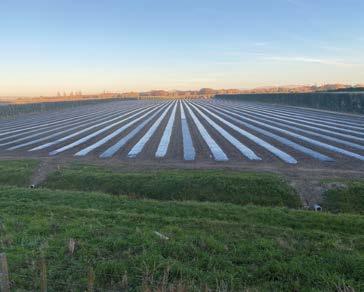

“We have developed a new ‘hybrid growing system’, the first of its kind, a cross between 2D (two-dimensional) and FOPS (Future Orchard Planting Systems),” Mark says. “It is a quad leader which we hope will lower the vigour of the semi dwarf CG202 rootstock.”
Waima Orchards brought in Ross Wilson from AgFirst to develop the system together.
Other upgrades have been to the drainage system (the basis of good growing with 20m spacing). Using GPS (global positioning systems) the drains are all laid out down the centre of the rows to lessen compaction over the drains to maximise the system’s ability to continue working for years to come.
All planting is now carried out with GPS along with other AI (artificial intelligence) and precision farming techniques and systems being adopted. Using drones and AI, Waima Orchards can measure the canopy density, pest pressure and nutritional requirements for each block, along with other technology to measure moisture requirements accurately.
They now have tractors that have the ability to drive themselves, mitigating the risk of rows of product being missed due to sprayer operator failures. These new tools are all fundamentals for sustainable profitability going forward, Mark says.
The ongoing wet that Hawke’s Bay has experienced since Cyclone Gabrielle has made it a difficult growing season, as pathogens and fungal spores have carried over. “It’s been pretty tough going, to be fair.”
“Hopefully with the change of government there will be more practicality in terms of labour from the Islands, because without them we just can’t get our crops off in a timely manner.”
Mark credits the Waima Orchards team for his positivity, including orchard manager Mark Simmonds and flood recovery manager Simon Kerr. It’s the team and the connection they have that he says has helped Waima Orchards build back, and to have resilience to be able to do it.
Like many others, Waima Orchards is planting back with more intensive plantings for higher production
“Mentally it hasn’t been an easy road, but when you work together as a team, towards a common goal, it makes life easier. These floods have only made us stronger”.
In terms of preparing for any future events of a similar nature, it comes back to civil defence early warning systems.
“We simply had no forewarning of what was coming, quite frankly it wasn’t good enough and we need a thorough investigation to seek the answers to the questions we all have,” Mark says. “We can ill afford committing to investing into large capital projects if we don’t have the right type of infrastructure needed to protect them.
The upgrade to the tile drainage system and fumigation of the rows, both using GPS for precision
The ORCHARDIST : MARCH 2024 11 YOUR INDUSTRY
Today the block is growing again, with RockitTM and Jugala trees on CG202 rootstock
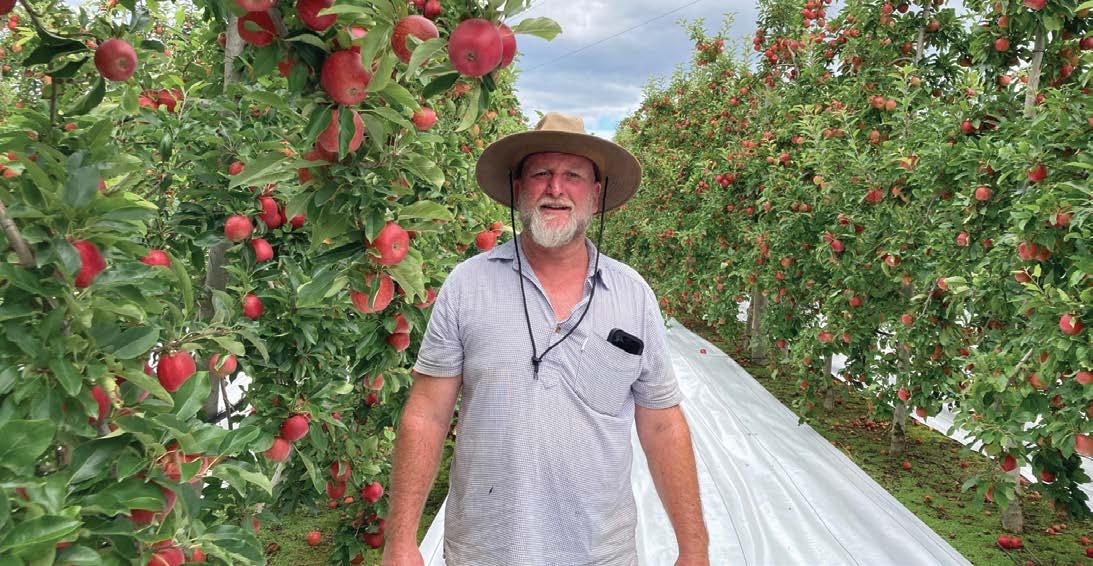
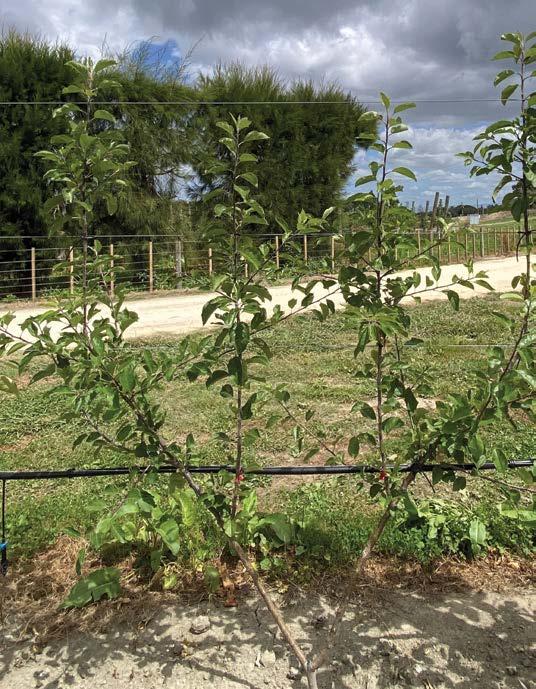
“The stopbanks that failed us all are still no different now to what they were, so we need changes from the local authorities to address this and now.”
NZ Apples and Pears are doing a research project about how its response as an organisation may be improved in future. While they were able to turn on a dime and help out as quickly as they could, coordinating with the various councils and civil defence, the response as a whole was fragmented because there was no one clear agency coordinating anything, Karen says.
These floods have only made us stronger
Karen was also part of the Environment Centre’s response team (now Sustainable Hawke’s Bay), which coordinated donations of essential goods after the storm.
Chief executive Emma Horgan-Heke says the biggest thing her team noticed after the floods was the number of Recognised Seasonal Employer (RSE) Scheme workers who came into the centre for support. “We had quite a few show up that didn’t have any support. We would encourage growers to think about what happens to workers in instances like this. We had to find them places to sleep and food, and so it would be good to know they were being looked after.”
Mark Simmonds is manager on Waima Orchards, part of the team that Mark Ericksen credits for their positivity in building back stronger.
Photo by Bonnie Flaws
12 The ORCHARDIST : MARCH 2024 YOUR INDUSTRY
The new block has been developed with a quad leader system which should lower the vigour of the semi dwarf CG202 rootstock

Another part of Sustainable Hawke’s Bay’s work is to look at nature based solutions as part of encouraging greater resilience against severe weather events, including encouraging more biodiversity or allowing more room for rivers – as opposed to hard engineering solutions like stopbanks. They have recently received some funding to undertake a couple of small research projects on how such approaches could be adopted by landowners.
There needs to be more focus on enabling communities to be ready
Emma says community resilience strategies may have to go further than having a shipping crate at the ready filled with generators and satellite links. There needs to be more focus on enabling communities to be ready, which involves studying changing weather patterns and water systems and what that could mean for growing practices.
“We look at adapting to climate change and how it will impact our communities. We are trying to think more holistically for our communities to be ready for more of these disasters.”
Waima Orchards’ G3 kiwifruit, a year after losing the entire crop in Cyclone Gabrielle
The ORCHARDIST : MARCH 2024 13 YOUR INDUSTRY
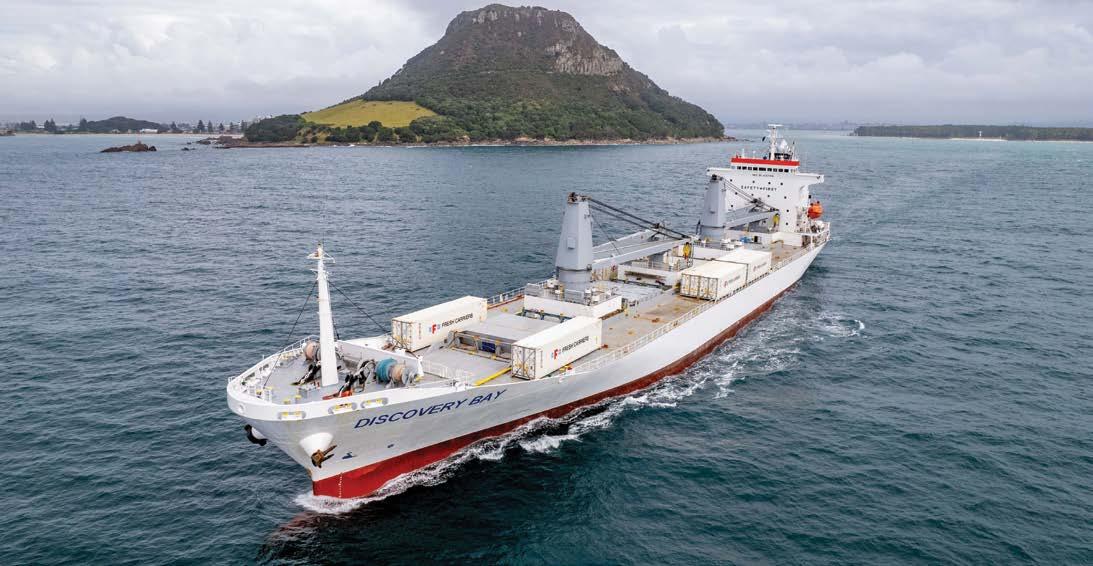
Decarbonising heavy transport to market
With the possibility of countries imposing carbon borders in the future, exporters like Zespri are taking the lead to future-proof our industry. Decarbonising those miles is not an easy task, nor one that growers have much control over. However, working together now may have a big impact on the future of horticulture trade.
The Orchardist staff
Each year New Zealand exports – mostly by ship –approximately 1.5 million tonnes of fresh fruit and vegetables. Despite the inherently low carbon footprint of fruit and vegetables, New Zealand’s distance from its markets means our produce racks up the food miles on the way to consumers.
Zero emission road freight is becoming a reality in New Zealand today, says Ryan McDonald, head of new business at Hiringa Energy. The Taranaki based producer of green hydrogen is building a refuelling network on key North Island heavy freight routes and is expecting to have
23 heavy duty Fuell Cell powered trucks operating on the network by the end of the year. The next decade will see the network rolled out around the country, linking growers with ports via zero emission green hydrogen.
However, in order to enable low-emission, or carbonneutral, shipping to our overseas markets we need a ready supply of marine fuel, and the infrastructure to enable vessel refuelling, Ryan says. With low emission cargo ships being built now, he says we need to be ready to fuel these next generation vessels by the end of the decade or they just won’t stop here.
CLIMATE SPECIAL 14 The ORCHARDIST : MARCH 2024 YOUR INDUSTRY
Last year, the kiwifruit industry used 57 charter vessel sailings during the season, plus another 13,300 containers. Photo by Jamie Troughton, Dscribe Media, courtesy of Zespri
“We need to stitch the whole value chain together domestically, from the production of low/zero emission fuels to the port bunkering and fuelling infrastructure necessary to enable it. And importantly, to understand the incentive for shippers,” he says. “Green hydrogen is only one part of the puzzle. Exporters such as those in horticulture are going to be a critical part of it, so they need to be part of the conversation with government around how to fund or incentivise the transition.”
At Fruit Logistica in Berlin last month, Bruce Marshall, global head of refrigerated cargo at Maersk, noted the shipping company’s goal was for 25 percent of its cargo ships to run on e-fuels by 2030, and for shipments to be net zero by 2040.
“We want to ramp up demand for e-Methanol,” Bruce says. Maersk and many other shipping companies are convinced that green technologies are the right approach to fighting climate change. Maersk’s objective now is to make customers understand that this entails costs.
Horticulture New Zealand supports low and zero-emissions fuels to fast-track the decarbonisation of international shipping and reduce New Zealand’s vulnerability to fluctuating global fossil fuel prices, as long as this does not impact the reliable supply of CO2 for horticulture. Hydrogen energy is one possible alternative to fossil fuels


















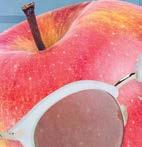



Panama canal capacity down 30%
Besides mitigating climate change with reduced emissions, shipping will also need to adapt to climate change –for example drought. The ongoing capacity issues at the Panama Canal are forcing some ships around Cape Horn, adding considerably to the journey.

for domestic freight and as a feedstock for international shipping fuels.
In multiple submissions to central government, Horticulture New Zealand has written that without shipping alternatives, global emissions pricing will increase fuel costs, driving up the prices of imported food and reduce market access for our exported goods.
These steps will require complementary policies from central and local government, like fast-tracking port upgrades to allow for larger, low or zero-emissions shipping vessels.






















The ORCHARDIST : MARCH 2024 15 YOUR INDUSTRY

What is e-Methanol?
E-Methanol is considered a good candidate to replace heavy fuel oil (HFO). Ship engines that burn e-Methanol produce a lower amount of CO2, particle and sulphur emissions compared to heavy fuel oil. E-Methanol still emits CO2 (1.4 kilograms per kilogram of methanol, versus 3.1 kilograms per kilogram of fuel oil), but its synthesis from green hydrogen and biogenic or captured CO2 makes it carbon-neutral. Currently e-Methanol can be up to twice as expensive as heavy fuel oil but packs only half its energy content, meaning that ships must carry more or refuel more frequently.
the world, however the shipping industry is also exploring other green hydrogen based fuels such as eLNG and green ammonia. They will all require vast amounts of renewable energy and green hydrogen.
Horticulture New Zealand has also advocated for policies that support the development of green hydrogen in New Zealand.
“Green hydrogen can help the horticulture industry reduce our transportation emissions and bolster our reputation as sustainable producers,” says Emily Levenson, environmental policy advisor. “Since our sector is reliant on trucks to move produce from farmgate to packhouse to port or domestic market, we could be an early adopter of hydrogen trucking if it was affordable. New Zealand can also position itself as an important stop in a green shipping route to pick up goods and refuel if we domestically produce hydrogen.”
Ryan believes the sector needs to focus on decarbonising its domestic supply chain and invest in infrastructure to produce our own marine fuels in New Zealand. E-Methanol has the advantage of established infrastructure around
What is green hydrogen?
Hydrogen is made using electricity to split water into oxygen and hydrogen. The ‘green’ before hydrogen means it was produced using completely renewable energy, meaning no carbon is emitted during the manufacturing process. Hydrogen has a higher energy density per unit mass than lithium-ion batteries, which is why it is being looked at for heavy-duty transport.
Supplying the huge amount of renewable energy required to produce enough green hydrogen to synthesise, for example, e-Methanol for bunkering cargo ships will require significant investment in large-scale new production capacity – with offshore wind energy best-placed to provide this, says Justine Gilliland, partnerships director for the partnership between BlueFloat Energy New Zealand and Elemental Group, which is developing two wind parks off the coast of Taranaki and Waikato.
Green hydrogen can help the horticulture industry reduce our transportation emissions and bolster our reputation as sustainable producers
She says offshore wind in New Zealand offers a huge natural resource with more reliable and much larger scale generation than, for example, solar farms, and without land use competition. “Offshore wind means we can preserve productive land for critical food production.”
Offshore wind and hydrogen production are currently more expensive, but the cost will decrease, Justine says, just as it has for solar and onshore wind. However, as a country we are already behind the curve.
“We need to decide on a national level as an export economy, are we not only talking about decarbonising food and fibre sector production within New Zealand, or are we going to also decarbonise the way we reach our markets, or even become a green energy exporter?”
The first heavy commercial Fuel Cell powered truck in New Zealand made possible by Hyundai and NZPost. By the end of the year 23 trucks will be operating on key North Island heavy freight routes.
Photo courtesy of Hiringa Energy
16 The ORCHARDIST : MARCH 2024 YOUR INDUSTRY
WHY AN ‘ALL HANDS ON DECK’ APPROACH IS NEEDED TO DECARBONISE THE SHIPPING INDUSTRY
In our industry we pride ourselves on providing high-quality, great-tasting and nutritious kiwifruit in a way that meets the needs and aligns with the values of our partners and consumers around the world. That includes a focus on strong environmental outcomes, whether it’s how we grow the fruit through to how we get it to market.
Shipping is going to play a pivotal role in enabling us to do this. Given New Zealand’s place at the bottom of the South Pacific Ocean, shipping plays a critical role in our country’s export-driven economy, carrying 99 percent of New Zealand’s trade by volume and around 80 percent by value. Globally, the sector is responsible for around 80 percent of worldwide trade volumes and 70 percent of worldwide trade value.
 Rachel Depree –Zespri executive officer sustainability
Rachel Depree –Zespri executive officer sustainability
The production of kiwifruit is a low emissions affair, with our total supply chain emissions accounting for ~2kg of CO2 emissions per kilogram of kiwifruit consumed. However, shipping emissions remain one of the key challenges to decarbonising and future-proofing our industry in an increasingly environmentally conscious and challenged world.
International shipping accounts for approximately 43 percent of Zespri’s emissions footprint for fruit sold globally. Last year, our industry used 57 charter vessel sailings during the season, plus another 13,300 containers, shipping over 619,200 tonnes of New Zealand kiwifruit to over 50 markets around the world.
We are also experiencing the need to adapt to meet changing regulatory requirements and the increasing consumer preferences for more sustainable practices across global supply chains, including decarbonisation.
25 % of Maersk cargo ships will run on e-fuels by 2030
At Zespri, having limited ability to directly reduce shipping emissions ourselves, our focus is on working with our shipping and distribution partners to increase efficiency and make the transition to low emissions fuels as we work towards being carbon positive to our retailers by 2030.
We’re seeing some positive progress, with the shipping industry starting to invest in alternative fuels and vessels, and a number of international ports preparing for these changes. Decarbonising the sector will take significant investment and we will continue to advocate for new port infrastructure and support the development of more sustainable shipping vessels, fuels and technology.
That’s why Zespri is working with a key European shipping provider to conduct a feasibility study to establish a Green Shipping Corridor. If successful, this would be the first customer-driven green corridor partnership in the world, and would allow other exporters and importers to reduce their international maritime emissions.
Achieving a green corridor is no easy feat. The shipping value chain is complex and ownership changes across fuel supply to ports, shipping companies and exporters. This is why we need all key players across the supply chain to work together to advocate for change. A collaborative approach with open dialogue between all actors in the supply chain can be complex and take longer, but if we are to continue to offer high-value products to the world and support New Zealand’s enviable agri-economy, we must take on the challenge. This year, 2024, is the year to dare to take on ambitious projects and embrace working with others to make an impact.
43 % of Zespri’s emissions footprint for fruit sold globally is from international shipping
The ORCHARDIST : MARCH 2024 17 YOUR INDUSTRY

Decarbonising with electric machinery
Electric options are beginning to make their way into the country –often accompanied by labour-saving automation capability.
The Orchardist staff
According to EECA, New Zealand’s off-road petrol and diesel powered vehicles, as well as other machinery such as frost fans and generators, contribute 3.89MT of C02-e emissions each year, using 1.1 billion litres of fossil fuels. Horticulture is just a part of that, but with the help of EECA’s Technology Demonstration our sector has already invested in electric options for dehumidification units, high-temperature heat pumps, electric frost fans, vacuum cooling units, electric harvest platforms and an autonomous electric tractor.
“Technology will make a marked difference for the sector in both energy and emissions savings – in many cases it has already been proven and more will become available,” says EECA general manager business, Nicki Sutherland. “Electrifying vital equipment is a key opportunity.”
EECA’s Technology Demonstration offers up to 50 percent co-funding to support energy and carbon savings through the early adoption of proven technology or an innovative process improvement opportunity.
The fund targets projects that reduce energy intensity or greenhouse gas emissions and businesses need to commit to having their project independently monitored and to promoting the project and outcomes.
Forest Lodge and 3 Kings Cherries are competing in the Otago regional Ballance Farm Environment Awards in April. Horticulture New Zealand is a proud national partner of the awards.
The MK-V Monarch electric autonomous orchard tractor during an open day at the fully electric Forest Lodge orchard in Cromwell
CLIMATE SPECIAL 18 The ORCHARDIST : MARCH 2024 YOUR INDUSTRY
Orchard electrification makes economic sense
Decarbonising orchard production is achievable right now, says Mike Casey. With his fully electric cherry orchard, Forest Lodge in Cromwell, Mike is a well-known leader of electrification. He is now also the chief executive of an independent charity called Rewiring Aotearoa, dedicated to making sure electrification is accelerated in New Zealand while ensuring New Zealanders enjoy the huge savings potential from a fair transition.
Energy ownership is very liberating and offers huge resilience benefits to boot
Achieving the world’s first electric orchard has been a long journey, he says, essentially sourcing 20 electric machines instead of buying the off-the-shelf diesel equivalents –everything from irrigation to frost fans. However, Mike encourages every orchardist to have a close look at the economics of electrification.
“When your orchard machinery needs replacing, you’re almost always better off buying an electric option,” he says.
With the already high price of diesel in New Zealand likely to increase, the economics stack up over the lifetime of your machinery, but access to upfront capital is the difficulty. Electric machinery is still expensive and can require upgrades to infrastructure such as switchboards and transformers.
Last year Mike imported a MK-V Monarch electric autonomous orchard tractor at a cost of $142,000 including shipping. While there has been support from the government in the form of EECA Technology Demonstration Funds, financing and insuring electric machinery is not always straightforward.
The price of electricity on the grid is already lower than burning diesel on the farm – particularly with off-peak spot rates for charging batteries. “We’re consuming 900% more electricity than the previous owners of the property, but half of that we generate ourselves and the other half we pull from the grid when it is cheap.”
The best value comes from using your own energy, for example through solar panels, he says. “You’re locking in your energy prices at 6 cents per kW/h for 25 years. Energy ownership is very liberating and offers huge resilience benefits to boot.”

| *This offer is for business customers only and is available on all new in stock Ferrari models purchased between 1 January 2024 to 30 April 2024. Any approved loans must be drawn before 31 May 2024. The 0.00% p.a. interest rate offer requires a 1/3rd deposit (based on the GST exclusive price) at the time of purchase, plus payment of the full GST component of the price, repaid in month 3 of the loan and is available for 24-month term loans. UDC Finance Limited lending criteria, fees, standard terms and conditions apply to any UDC loan. Details of terms and conditions will be specified in the loan document. Fees are available on request. The ORCHARDIST : MARCH 2024 19 YOUR INDUSTRY

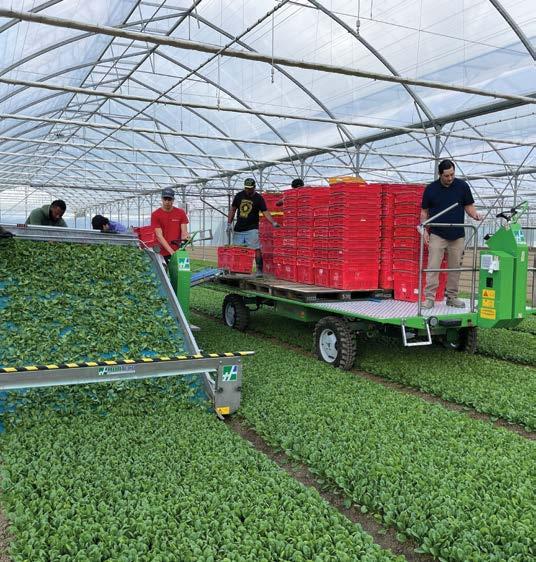
Global farm machinery manufacturers see demand for electric
Demand from growers was behind the development of the Electric GUSS, a fully electric version of John Deere and GUSS Automation’s autonomous herbicide orchard sprayer, which was unveiled last month in California. The Electric GUSS utilises Kriesel batteries that can run and spray for a full shift when fully charged. John Deere says the machinery is now available for order in New Zealand. “We’ve been asked countless times about making GUSS electric,” GUSS Automation Chief Operating Officer, Gary Thompson says. “An electric herbicide sprayer made the most sense to us, given that the battery life can last an entire shift while performing this critical orchard task. Combining the battery’s electric benefits of low operating costs and zero tailpipe emissions with spot spraying weed detection technology makes Electric GUSS a winner.”
Using a combination of GPS, Light Detection and Ranging (LiDAR) and proprietary technology for accurate coverage, a single employee can operate and monitor up to eight GUSS machines from the safety of their vehicle using a laptop computer, reducing the opportunity for operator exposure.
Vegetable grower trials electric harvester and cargo platforms
Technology and innovation continue to advance in the electric space, particularly in controlled environments, says Leaderbrand. But there is still a lot of research needed around scenarios involving work in the open field situation
with variable workloads and potential to be far away from charging stations.
General manager of farming Gordon McPhail says that reducing emissions, fuel and oil as well as finding new ways to farm sustainably and with new technology is an important focus for LeaderBrand.
The new Hortech eco-slide electric harvester and Hortech cargo platform are both a first of their kind to New Zealand and specifically designed to suit LeaderBrand’s indoor environment and cropping system with quality, accuracy and harvesting widths.
“We’re always looking for different ways we can be more climate friendly, and this is another step in the right direction. It’s also great for the safety of our team as the electric harvester is less noisy than our diesel engines, which is helping to improve communication and safety for our teams in the greenhouse.
“The greenhouse is the right environment for us to trial and test if electric equipment will work in our business. In fact, we designed the front packhouse of the facility with electric harvesters in mind getting the wiring and outlets built into the greenhouse before we’d commissioned the equipment,” he says.
“With overnight charging we can get a solid 12-hour run time on the harvester which is more than enough power to get us through the day which suits our busy team perfectly,” he says.
LeaderBrand was awarded an EECA grant which has helped with some of the cost of investing in an electric harvester.
Inspecting the Electric GUSS, a fully electric version of John Deere and GUSS Automation’s autonomous herbicide orchard sprayer
20 The ORCHARDIST : MARCH 2024 YOUR INDUSTRY
LeaderBrand’s new Hortech eco-slide electric harvester and Hortech cargo platform are both a first of their kind to New Zealand

Say hello to low carbon crops
Its time to make the transition, tap into the benefits of decarbonisation and prepare your business for the future.
The Covered Cropping Decarbonisation Pathway will give growers access to:
• International expertise
• Best practice guidance
• Bespoke tools and resources.
Discover more at eeca.govt.nz/coveredcropping


Peacharines flourish in Mangaweka microclimate
They call it a summerfruit orchard, but Diana and Grant Baird pick their peacharines and plums at their Mangaweka Fairview Orchard in the early autumn, making it one of the latest seasons for orcharding in New Zealand.
Aimee Wilson
The Kawhatau Valley has grown abundant peacharines for over 30 years, along with Black Doris and Omega plums, and a new Sweet Dream peach variety.
The legendary Healey’s Peacharine is Diana’s pride and joy, while apricot and nectarine plantings have been replaced over the years. But they’re constantly planting new trees and trying out new cultivars.
“If we have a new variety we have a two bite taste test: 1. Do we want to have another bite? 2. Do we want to finish the fruit?” she says.
Several Central Otago growers also grow peacharine varieties and the two areas have similar seasonal characteristics – except for the high rainfall in the Mangaweka.
Renowned for being difficult to grow, the peacharine has superior eating qualities and the microclimate of the Kawhatau Valley is a perfect environment for it.
At 550m there isn’t a day of the year that hasn’t at some stage been affected by frost in the past 100 years. “No I don’t just light my fire on Christmas day for the ambience,” Diana says.
The rainfall is also high, and this part of the country has not escaped the flooding affecting many areas in recent years, with structural repairs to bridges and State Highway 1 still currently threatening to drop into the river.
“The challenges that we face are often quite different from other growers,” Diana says.
22 The ORCHARDIST : MARCH 2024 YOUR INDUSTRY
Diana Baird on the orchard near Mangaweka

Access to spray and equipment, packing facilities, and the ability to borrow from neighbours isn’t so straightforward for Diana and Grant and their son, who are also sheep and beef farmers.
“If gear breaks down, we don’t just have contractors close by to call on.
For summerfruit, cool chain transportation to markets is critical when fruit is sent to retailers all over the North Island.
The fruit is grown in soils where nutrients are actively monitored and micro-organisms tailored for optimum plant health and ongoing sustainable production.
Growing an abundance of fruit comes from being careful, Diana says, and prides her husband Grant on being a very good orchardist.
“He’s very interested in what he does, carrying out a lot of crop monitoring while he’s spraying. We’ve done a lot of work with biologicals in recent years.”

Being harvested late in the season, the fruit is exposed to longer sunshine hours, which Diana says give it higher levels of Vitamin A, carotene and Vitamin C.
Renowned for being difficult to grow, the peacharine has superior eating qualities and the microclimate of the Kawhatau Valley is a perfect environment for it
Back in 2008 and 2012 Fairview Orchard won Ballance Farm Environment Awards for nutrient management, crop management, water management and innovation.



“It’s an endorsement from peers that you are doing good
The ORCHARDIST : MARCH 2024 23 YOUR INDUSTRY Est 1956 L.E. Cooke Ltd L.E. Cooke Nurseryman Growers of high quality fruit trees your fruit tree Try us first for requirements! Marty & Kelli Cooke 75 York Road, Longlands, Hastings, 4120 PH: 06 870 7043 EMAIL: lecooke@xtra.co.nz CELL: 0274 396 205 (Marty) NurserymanLtd •Pears •Plums •Apples •Apricots •Cherries •Peaches •Nectarines www.lecooke.co.nz Proudly serving the fruit industry for 68 years
Looking across farmland and Fairview Orchard beneath the Ruahine Ranges


Diana and Grant make a real effort to attend SummerGreen grower days and conferences, acknowledging that support and advice from their peers and industry leaders is often difficult for them to access in their part of the world.
Although her experience in the corporate business world set her up well for contributing to the family orchard, ten years ago she went back to university to upgrade to a Master’s degree. This reassured her that sticking to their strategy of niche marketing of plums and peacharines was the right move.
“You either need to be so big and drive the internal economics, competition and the monopoly, or set the terms to be a niche market. There’s not really any middle ground.” It is with smaller players that you often find innovation, she says.
“And we are smaller, in an out-of-the-way spot, and do weird things… the very definition of ‘niche’. At the end of the day I’m just interested in producing fruit that reliably tastes good.”
Looking back on her orcharding life, one of the mentors when she first started that stands out for Diana is the late Basil Goodman. Ignorantly seating herself at the directors’ table at the MG Marketing Annual General Meeting many years ago turned out to be the best move – she gained some valuable advice from the Summerfruit NZ guru, and describes him as revolutionary.
“Basil Goodman once said to me that you need reliable access to labour and transport. I agree that without them you are spitting in the wind,” Diana says.
Diana loves the people and getting out either in her community offering fruit at church on Sundays, or heading to the city to meet her big clients. She’s either selling fruit or giving it away, and people are at the heart of the business.
“When it’s all working well, it’s just a dance.”
Just like when you walk into a packhouse and see everybody busy and the fruit constantly moving, it’s all harmonious and with its own rhythm.
GEOGRAPHIC DIVERSIFICATION BEARS FRUIT
In the 1980s the National Government initiated a diversification strategy, and a team of experts visited the Taihape district, pronouncing it suitable for growing apricots, asparagus and garlic.
A flurry of planting ensued, and eight orchards sprang to life – but Fairview invested in frost protection and was the only one that survived. Grant Baird married Diana and continued planting as their own family grew. Apricots were succeeded by nectarines and peaches and finally peacharines proved the most successful.
Grant Baird and grandson Ben eating plums on Fairview Orchard
The famous Healey’s Peacharine – grown here for over 30 years
24 The ORCHARDIST : MARCH 2024 YOUR INDUSTRY
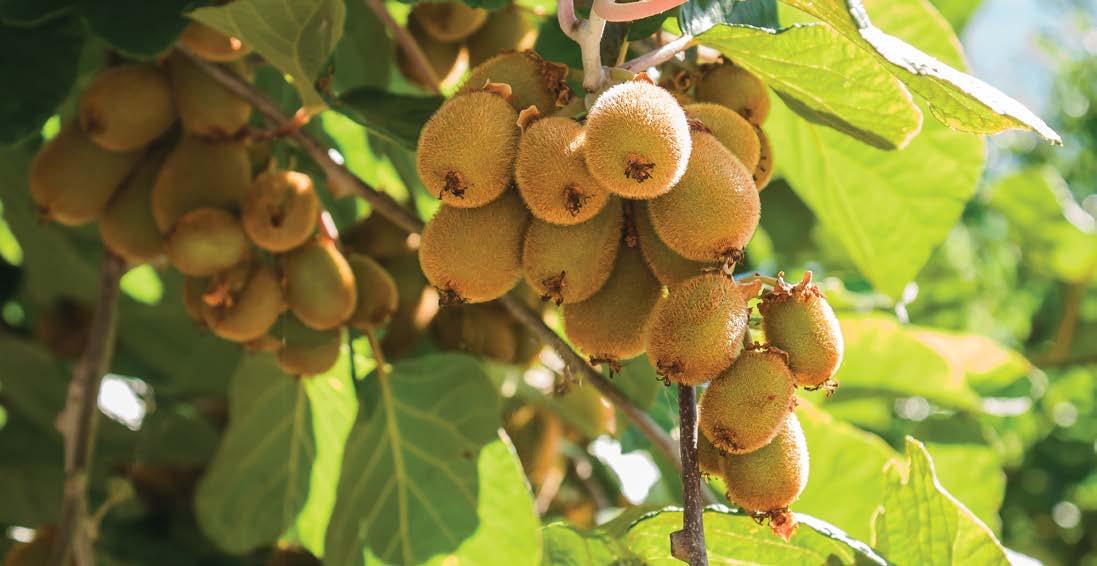
Crop suitability changes with the climate
Climate change will see some growing areas challenged in producing some existing crops in the future but also new areas of opportunity opening up, Plant and Food Research senior scientist Kumar Vetharaniam says.
Karen Trebilcock
Kiwifruit is a great example, he says. Although kiwifruit needs a warm, frost-free growing season, it also needs sufficient winter chill to ensure good budbreak and flowering in spring. As the climate changes throughout the century, many areas of New Zealand could see increased temperatures that reduce frost risk and increase growingseason warmth while still providing sufficient winter chill. This would offer new growing areas for the kiwifruit industry.
“There is a large variation in chill requirement between different kiwifruit cultivars,” Kumar says. “In areas where increased temperatures reduce winter chill, growers may be able to use mitigation strategies such as replacing cultivars with those that have lower winter chill requirements. More effective budbreak enhancers would also be a valuable tool.”
This winter chill study complements a 2021 report by Plant and Food, funded by the Ministry for Primary Industries, which focusses on seven perennial crops –apples, avocados, blueberries, cherries, kiwifruit and two varieties of wine grapes – but the information can be used by all growers whose crops have similar environmental needs.
The modelling is not intended to be prescriptive, Kumar says, but rather to portray how growing conditions for different crops will be affected under different climate trends. The climate projection data has the resolution of a 5km x 5km grid so does not reflect the different microclimates that can exist within a grid cell. These microclimates can provide different (better or worse) growing conditions than the grid cell average.
CLIMATE SPECIAL The ORCHARDIST : MARCH 2024 25 YOUR INDUSTRY
Increased temperatures that reduce frost risk and increase growing season warmth while still providing sufficient winter chill could mean new growing areas for the kiwifruit industry
KIWIFRUIT SUITABILITY AND CHILL BANDS UNDER CLIMATE TRENDS
Figure 1 represents the historic situation. Figures 2 and 3 represent the projected situation late this century under a slower and faster rate of climate change, with researchers currently expecting somewhere in between. Figure 2 also corresponds to the faster rate of climate change by the mid-century.
Chill bands
6: get very high winter chill, and suit all cultivars
5 (‘Hayward’): optimum winter chill for all current New Zealand kiwifruit cultivars
4 (Tetraploid): suit ‘Zesy002’ but not ‘Hayward’
3 (‘Hayward’ + BBE): represents lower chill areas that would be suitable for all current New Zealand cultivars with the application of an effective budbreak enhancer
2 (Tetraploid + BBE): suit ‘Zesy002’ with the use of effective budbreak enhancer, but not ‘Hayward’
1: get very low chill and suit only lowest chill cultivars
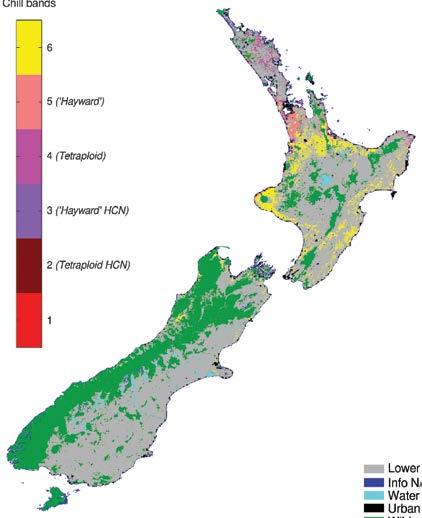
Key
Not highly suitable for kiwifruit cultivation Info N/Av
Irrigation is assumed to be available and so rainfall requirements are not evaluated. Plant & Food Research is currently updating models to include rain, and also the impact of wind which has proven to be a significant factor influencing crop yields.
This research considered four different scenarios for future atmospheric greenhouse gas (GHG) concentrations, and so four different rates of warming, with the climate data provided by NIWA.
It complements work already done in the agricultural sectors.
Kumar says when the research was first started, the highest GHG scenario of the four was often referred to as “business as usual” and was the expected outcome with no steps for GHG mitigation.
However, this rate of warming is now considered less likely by the Intergovernmental Panel on Climate Change, as the world begins to mitigate GHG emissions.
“Growers could now expect conditions to be in between the two scenarios,” he says.
Water Urban Wilderness
-34 -36 -38 -40 -42 -44 -46 -48 Latitude Longitude Figure 1 166 168 170 172 174 176 178 26 The ORCHARDIST : MARCH 2024 YOUR INDUSTRY

The lack of winter chill will result in reduced suitability in many parts of the upper North Island and around East Cape, with Northland most affected.
Regardless of the rate of climate change, researchers expect an increase in the overall area in New Zealand where current cultivars can be grown.
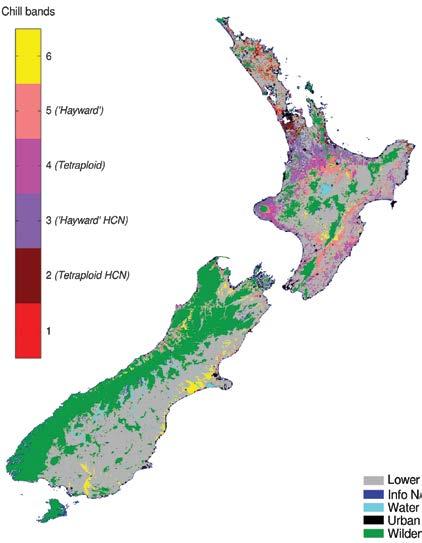
In parts of the central and lower North Island and some of the South Island such as Canterbury, locations could become more favourable for kiwifruit growing.







-34 -36 -38 -40 -42 -44 -46 -48 Latitude Longitude
2 -34 -36 -38 -40 -42 -44 -46 -48 Latitude Longitude 166 168 170 172 174 176 178 166 168 170 172 174 176 178
3
Figure
Figure
The ORCHARDIST : MARCH 2024 27 YOUR INDUSTRY 0800 735 859 www.bdmax.co.nz See the website for HortResearch report 10264 & 9 years of grower experience. Available from Farmlands & Horticentre. Excellent results to -2°C ThermoMax • Provides internal warming more compact flowering • For use on fruit tree crops • The “spray on” that adds to all other methods • Good results have been achieved when applied through irrigation lines Frost Protection
GMOs and new breeding techniques
After 30 years of little change, 2024 might usher in a big change in New Zealand’s genetically modified organism (GMO) regulations. The government coalition agreements to liberalise the GMO regulations have reinvigorated debate about the technology. Horticulture New Zealand encourages all growers to join the conversation as the industry engages with the government on how New Zealand regulates GMOs and new breeding techniques.
The Orchardist staff
What is a gene edited plant and is it different to other GMOs?
While there are no agreed definitions, gene editing often refers to new breeding techniques developed in the last decade, including CRISPR-Cas9, which involves making changes at targeted, precise points in the genetic code, often without adding DNA. These new tools are more efficient and less expensive than older genetic modification technologies established in the last century, which tend to make changes and add DNA at uncontrolled, random points in the genetic code.
Many countries have grappled with the definition and decided that organisms developed with new breeding techniques should be regulated differently than those developed with older technology. Some countries have updated regulations in a narrower way – regulating organisms modified without any insertion of external DNA differently from those organisms modified with added DNA or genetic material.
However, many people see the distinction between the technologies as unnecessary, arguing that any modification that does not occur naturally will result in a GMO (as is currently the case under New Zealand regulations).
What does genetic engineering have to do with climate adaptation?
Many researchers, lawmakers and investors believe that new breeding techniques could address the looming threat of climate change by developing plant varieties that are climate resilient, pest resistant, produce higher yields or require fewer fertilisers and pesticides, and potentially at a faster pace than through traditional breeding.
Conversely, genetic engineering has also been used to create herbicide-tolerant crops, which could lead to increased use of weed sprays and increased risk of herbicide resistance in weeds.
There are also scientists who argue that agroecology and traditional breeding techniques have already delivered far better solutions for climate adaptation than decades of GMO development. They suggest that there are likely more promising traditional breeding or agroecological solutions to climate change that have not been fully explored.
What impacts could global regulatory changes have on growing in New Zealand?
In the 50 years since the introduction of genetic engineering, New Zealand horticulture has proven very competitive on global markets without it. New Zealand’s current regulations do not in theory prevent such developments, however in countries with liberalised regulatory regimes, the efficiency of new breeding techniques is enabling researchers to develop products on a larger scale.
New breeding techniques could address the looming threat of climate change
As these become commercialised, this produce grown overseas could compete with New Zealand horticulture. As an example, gene edited fresh produce such as non-browning apples could become a consumer preference. New Zealand growers may not be able to produce a competing product through traditional methods or grow the gene edited variety because of our current GMO regulations.
28 The ORCHARDIST : MARCH 2024 YOUR INDUSTRY
WHAT COULD BE THE BENEFITS OF NEW BREEDING TECHNIQUES FOR VARIETY DEVELOPMENT?
New Zealand already has an impressive track record of developing new varieties to cater to changing consumer preferences around the globe, says Professor Richard Newcomb, chief scientist at Plant & Food Research. He has spoken with several industry boards and growers about the demand for new genetic engineering technology to supplement traditional selective breeding techniques.
“Consumer demand and time to market is really speeding up. The wellness trend is really ramping up. At the same time, the input traits we need to consider are changing fast. Climate change, temperature, pests and diseases – for example, could we develop plant resistance to Brown Marmorated Stink Bug before it gets here? Horticultural crops require winter chilling, and that will be a problem for just about all our perennial crops. We need to be ahead of the game, but with the traditional approach we cannot keep up with the pace of climate change.”

Professor Richard
New breeding techniques have developed quickly. Emerging technologies, such as CRISPR-Cas9 which resulted in a 2020 Nobel Prize for its developers, allow precise modification of genomes.
“The increase in precision is shifting thinking about genetic engineering – the perceived risks are decreasing. Overseas, only benefits have been observed.”
Richard says that New Zealand is reasonably well-prepared to catch up with global biotechnology. “We’ll need some infrastructure, such as containment greenhouses, but we’re not expecting an avalanche of GMO technology in New Zealand. We have to have those conversations first with partners, put a plan together, make sure we are aligning with our target markets. We have to balance a whole range of factors –not just economic but also environmental and consumer perception.”
In our world of twigs and roots pedigree is everything.

As we all know, in the fruit growing industry ultimately everything stems from a twig. We have alliances with some of the world’s best new fruit variety developers and rootstock breeding programmes. These relationships and our continual search for the best cultivars puts us at the forefront of global variety and rootstock development in New Zealand.






Our unique capability across a wide variety of crops and our focus on matching varieties and rootstocks to conditions allows us to offer real, informed advice. Call:
Grant Bryan, 0274 201 003, grant.b@waimea.group
Kate Marshall, 0274 201 033, kate.m@waimea.group


www.waimeanurseries.co.nz
The ORCHARDIST : MARCH 2024 29 YOUR INDUSTRY
Newcomb, chief scientist at Plant & Food Research, says New Zealand cannot keep up with the pace of climate change without new breeding techniques
GMO s : LEARNING FROM THE AMERICAN ORGANIC MARKET
Organic standards differ around the world, but one thing they all agree on is that genetic engineering and GMOs are prohibited.
“The output is based on natural production and that’s why consumers buy organic products,” says Tiffany Tompkins, chief executive of Organics Aotearoa New Zealand (OANZ). Now based in Blenheim she is an American who has wide international experience and been an organic supplier to United States retailers like Whole Foods Market.

New Zealand has a great reputation as an island nation producing guaranteed GE-free food
Tiffany Tompkins is chief executive of Organics Aotearoa New Zealand, which argues for strict regulation and oversight of genetic engineering
She has witnessed how the United States has grown into both the world’s biggest producer of GMOs, as well as the world’s biggest market for organic products.
“That’s a fact that I sometimes hear as an argument in favour of genetic engineering, but this has created huge problems for organic and conventional growers in the States. GMO crops contaminating non-GMO crops has led to a lot of lawsuits. We also see growers getting stuck into a cycle of dependency on biotech companies for seeds, herbicide and pesticides and fertilisers, only to grow commodity-level crops that pressure farmers to maximise yields, further perpetuating monoculture farming practices. All the while, the intellectual property is bound up with corporates. The money is not going into grower hands.”
15 % of all fruits and vegetables sold in the USA are now organic
The relaxation of regulations on genetic technologies in the United States has eroded consumer confidence in the country’s food supply, Tiffany says. This presents an incredible opportunity for New Zealand’s exporters.
“New Zealand has a great reputation as an island nation producing guaranteed GE-free food and that’s what consumers are increasingly looking for.”
With the United States organic market valued at over US$64 billion and 15 percent of all fruits and vegetables sold in the USA now organic, Tiffany says the astounding fact is that 80 percent of organic products are imported to meet this demand.
Market opportunity is only one benefit of the organic sector. For example, in the European Union (EU), she says lawmakers see organics as a key driver to increase sustainable value for growers and communities, both in economic value and environmental value.
OANZ argues for strict regulation and oversight of genetic engineering to prevent unintended consequences. The long-term effects of the technology on human health and the environment are not fully understood.
“We don’t know enough about the soil microbiome already, let alone with genetically engineered plants. Once they are in the ground, in the wild, what will be the effect on biodiversity? What will be the effect on our economy?”
80 % of organic products are imported to meet this demand
>$64 bn
United States organic market value (USD)
30 The ORCHARDIST : MARCH 2024 YOUR INDUSTRY
BIOTECHNOLOGY IS PART OF OUR DAILY LIVES
In 2003, thousands of New Zealanders marched down Queen Street in Auckland to show their opposition to GMOs. But opinions are shifting, Plant & Food Research biologist Revel Drummond believes. He is currently on secondment to advise the Prime Minister’s chief science advisor Juliet Gerrard.
“When people realise how much they already rely on biotechnology in their everyday lives, it makes it a lot less scary. Even here in New Zealand we interact with genetic engineering every day. Almost all cheese in New Zealand, washing machine powder, medicines –they all use enzymes created with genetic engineering.”

Last month, parliamentarians in the EU voted in favour of a proposal to relax regulations on new genomic techniques that do not introduce genetic material from species that would not otherwise be able to cross. Until now the EU has had the strictest GMO rules in the world – on a par with New Zealand – requiring exhaustive assessments that have more or less prevented any genetic engineering developments.
He says food safety authorities around the world have concluded that there are no new hazards specific to GMOs. Over the last 30 years almost three billion hectares of genetically engineered crops have been planted around the world – mostly arable crops but also apples, potatoes, eggplant, squash, papaya and pineapple. Products from those crops, such as canola oil, are already consumed here in New Zealand; the oil itself contains no modified DNA matter so is not labelled as GMO.
Despite the world’s rapidly developing biotechnology, New Zealand is still regulated by the Hazardous Substances and New Organisms Act 1996, modified in 2003 to tightly regulate research into genetic modification.
“The new rules leapfrog the EU to a much more permissive regime, regulating gene edited plants with a limited number of changes with the same rules as new plant varieties developed with traditional breeding techniques. It’s not surprising when you think that traditional breeding can result in enormous changes, such as nashi pears or plumcots, with many thousands of trait changes – and none of which have had any impact on human health.”
There are certainly risks, he says, but the risks apply to new varieties created with traditional breeding techniques too. He gives potatoes as an example, which are well known for potential toxins. But food safety is not the only concern, he says. New Zealand should take into account all the social, cultural and ethical considerations.
“We have to decide how we will interact with this biotechnology to manage the risks. Yes, biology is messy. Life is messy. But we should look at how biotechnology can improve our lives.”
HOW WILL GENETIC ENGINEERING AFFECT YOUR MARKETS? SHARE YOUR OPINION IN THE ORCHARDIST
In the coming months, The Orchardist will continue our coverage of GMO and new breeding techniques. Note that views expressed do not necessarily reflect Horticulture New Zealand’s position.
To share your opinion, please email John Gauldie, acting editor: editor@hortnz.co.nz
 Biologist Revel Drummond is currently on secondment to advise the Prime Minister’s chief science advisor.
Biologist Revel Drummond is currently on secondment to advise the Prime Minister’s chief science advisor.
The ORCHARDIST : MARCH 2024 31 YOUR INDUSTRY
Photo courtesy of Plant & Food Research

Adaptation key for Northland’s horticulture
Regions like Northland have been hit hard by many adverse weather events, but growers are determined to adapt. HELENA O’NEILL talks with Kathryn de Bruin and Anna Curnow about the work underway to secure the future of communities and horticulture in Northland.
Photos by Trefor Ward
Kathryn de Bruin is an accountant, Horticulture New Zealand board member, and kūmara grower with her husband Andre near Dargaville.
“Our whole farm got flooded during Cyclone Gabrielle and we lost about 80 percent of our crop. It wasn’t unique, the whole industry had people who were affected. The biggest damage that happened to us happened when the Northern Wairoa River flooded over its banks after the cyclone. It was that flooding that was the nail in the coffin for us,” Kathryn says.
Floodwaters were up to chest height on parts of the property.
The De Bruins received the Cyclone relief funding from the Ministry of Primary Industries which was used to fix up the riverbank damaged during the cyclone. This was supplemented with some of their own money, to ensure their property has a riverbank that is high enough to protect it from flooding during king tides.
“There has been no planning at a local level around that sort of event … there’s no comprehensive management around this.”
One way Northland can adapt is through land use change and implementing projects supporting potential conversions to horticulture.
CLIMATE SPECIAL 32 The ORCHARDIST : MARCH 2024 YOUR INDUSTRY
Kathryn de Bruin is one of three trustees of Te Tai Tokerau Water Trust, which has three reservoir projects primarily being developed to encourage the transition to higher value horticultural land use
Suitable land for horticultural development is increasing in value across the country and a consistent supply of water is key to unlocking this potential. With access to water, landowners can consider more diverse and profitable land uses. Te Tai Tokerau Water Trust says that reliable water means consistent production for existing growers and reduced risk for those looking to switch to a new, higher-value crop.
Kathryn is also one of three trustees of Te Tai Tokerau Water Trust.
“It’s not profitable to have a small block running animals, whereas it might be possible to be profitable with a small block with some sort of horticulture on it,” Kathryn says.
The project also aims to address disparities in Māori access to water
The trust has three reservoir projects: Matawii near Kaikohe, Te Waihekeora in Kaipara, and Otawere at Waimate North. The scheme is primarily being developed to encourage the transition to higher value horticultural land use, as well as to supplement local town water supplies.
The trust received $68m from the government’s Provincial Growth Fund to complete the first stage of the project –of this $8.5m is in the form of a grant, the rest is a loan. The next stage of development, which will see the schemes in both regions enlarged, will be funded by the successful implementation of stage one.
“The trust is building the reservoirs, and when they’re completed, they will be ‘sold’ into co-operative type companies to be owned by the people who are using the water.”
The project also aims to address disparities in Māori access to water for land development. Development of the scheme is expected to lift employment by 12 percent in the Mid-North and five percent in the Kaipara per annum.
“Northland in some respects is a poor cousin when it comes to infrastructure. There hasn’t been any major infrastructure put into Northland for such a long time. This is one of the first big projects that has happened on a community scale.”
The Matawii and Otawere reservoirs make up the Mid North Water Scheme around the Kaikohe region with a combined estimated storage of five million cubic metres to service up to approximately 1700 hectares of new horticultural land in the area.

The ORCHARDIST : MARCH 2024 33 YOUR INDUSTRY
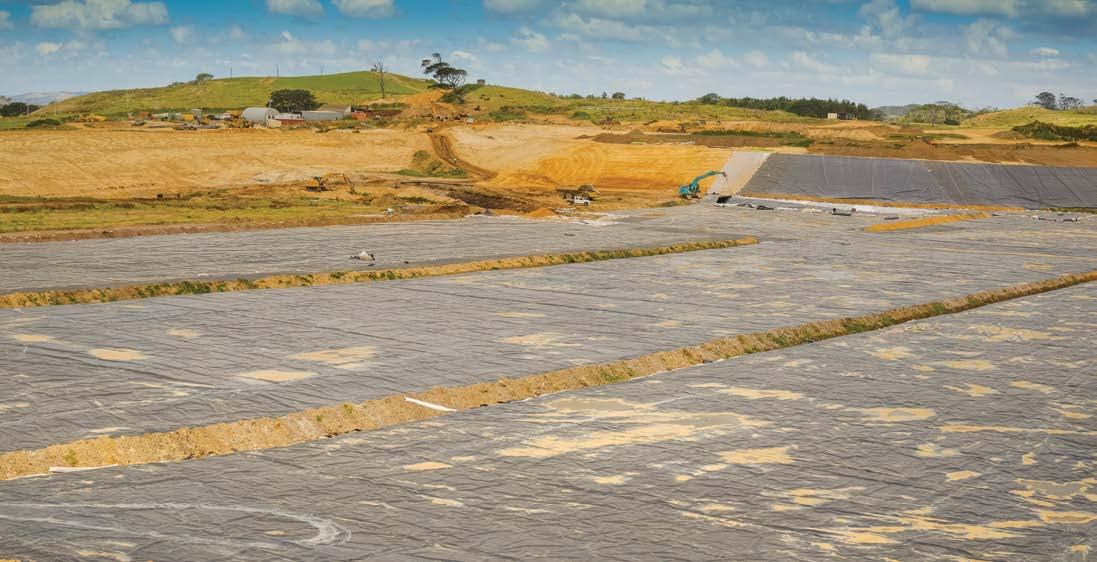
The Kaipara Water Scheme consists of Te Waihekeora reservoir at Redhill on the Northern Pouto peninsula. Situated in a natural basin 75 metres above sea level, on top of rolling sand dunes, the reservoir is being constructed in two stages, and once completed will hold sufficient water to support around 1100ha of new horticultural development.
Kathryn says that the water scheme around Kerikeri offers a wider range of land use coupled with economic benefits through the development of horticulture operations. She hopes that the success of Kerikeri’s water scheme will be seen in the Mid-North and Kaipara areas of Northland once the three reservoirs are completed.
“As the climate gets warmer, it’s only going to become more important for people and animals, let alone horticulture.”
Anna Curnow is passionate about the need for regions to embark on climate adaptation work to future-proof their communities. The former Kaipara District Council deputy mayor and climate adaptation specialist is a key member of a pilot programme based in Ruawai near the Northern Wairoa River and Kaipara Harbour.
Set up in 2021, the Ruawai Adaptive Pathways (RAP) pilot project aims to prepare for and respond to coastal hazards, flood hazards and sea level rise in the Ruawai area, land lying mostly at or below sea level.
Ruawai was chosen by Northland’s four councils as the region’s first pilot location, to provide information and modelling for the region and other councils around the rest of New Zealand.
“Public adaptation planning is a process of bringing representatives of communities together to understand the risk – understanding the science of the risk and the consequences of those risks on those communities. Each community is different, and each has different tolerances to risks,” Anna says.
She says once risks are identified, a community decides what actions they want to take, with each council’s job to “give life” to those solutions.
Anna says that insufficient funding and a lack of political will can be major barriers to local planning. Communities must have ownership of their climate adaptation actions, making informed decisions without the central government telling communities what to do.
“It’s not a cheap process. We’ve had a lot of that engineering and scientific work done already. It needs resourcing and that’s where councils were useful, as they were providing that resourcing. When I was deputy mayor, we did assign funding in the Long Term Plan dedicated to that pilot.”
Late last year the Kaipara District Council (KDC) halted the community pilot for the rest of this financial year, much to Anna’s disappointment. The programme was about halfway through its projected two or two-and-a-half-year duration. KDC’s formal consultation on Ruawai Adaptive Pathways is planned to take place this month (March) as part of its Long Term Plan 2024–2027 discussions.
34 The ORCHARDIST : MARCH 2024 YOUR INDUSTRY
Once completed Te Waihekeora reservoir at Redhill on the Northern Pouto peninsula will hold sufficient water to support around 1100ha of new horticultural development

Growing at the top of the country
Tucked away in the Far North of New Zealand is a sprawling operation owned by Ngāti Kuri, producing avocados, blueberries, native plants and several trial crops. HELENA O’NEILL talks to Waimarama Orchards manager Lisa Everitt about Māori horticulture and the challenges of growing in Northland.
Photos by Trefor Ward
Waimarama Orchards is the most northern orchard in the country, located around 38km from Cape Reinga. It’s also thought to have one of the largest man-made dams, which removes the need to draw water from the aquifer.
The property is over 300 hectares with about 60ha of that operating as an orchard, alongside a native plant nursery, with the remainder of the land leased out to Ngāti Kuri’s own sheep farming operation Te Paki & Wharekapua. Orchard manager Lisa Everitt has worked in a range of sectors including farming, hospitality, education (as a teacher aide), customer service retail administration, business specialist team manager, with health and safety and team management being her core training.
“On my move back from Australia I was lucky enough to have a chance meeting with Kevin Wilcox, the managing director of A.S. Wilcox and Sons Ltd. Kevin offered me a position in the Northland office which was administrative along with health and safety. This position grew and I also undertook some fieldwork, including land preparation and harvesting. During the Covid-19 pandemic, we ended up with a small team. We still had considerable land to prep for the coming season’s potato (perla) crop and carrots, so three of us undertook all land preparation and planting during our first lockdown. This was a vast learning curve.
The ORCHARDIST : MARCH 2024 35 YOUR INDUSTRY
The team behind Ngāti Kuri’s Waimarama Orchards operation near Cape Reinga


“Following my move from Wilcox, I still have some key contacts who I maintain an excellent relationship with and who are extremely supportive with cropping and agronomy knowledge sharing.”
At peak we have 80 staff for harvest through both core crops; in balance we carry 20 to 30 staff throughout the year
About three years ago Lisa began working for Te Urangi O Ngāti Kuri at the orchard, originally as operations manager at Waimarama Orchards, before moving into the manager role in December 2022.
“We have two core crops, two trial crops and our native nursery. I have two crop leads, both young wahine in their early twenties and keen to learn and have ownership, one general works and infrastructure supervisor who has been with Waimarama since 2011, and a lead in our native nursery. At peak we have 80 staff for harvest through both core crops; in balance we carry 20 to 30 staff throughout the year.”
The operation is a multi-crop orchard to envisage longevity of employment and seasonal moves as well as the commercialism of the orchard. It has 21,000 blueberry plants in four varieties sourced from Mountain Blue in Tabulam, New South Wales, and 16,200 avocado trees primarily supplying the pre-season domestic market.
“We had a really good early avocado harvest starting in May. We were the first to market this year again. Going out at that time was significant because pricing was sitting between $37 and $39 per tray. We picked for about 15 days and harvested about 170 tonnes. By the first few weeks of June, the prices had dropped significantly. “Having that early fruit has helped us a lot. Between 75 and 80 percent of our crop was done and dusted before any of those really low prices. The pre-season domestic market is what we sold into. We didn’t do any export until about November, with a limited amount because by then it wasn’t worth putting people out there to pick.”
Pruning gets underway immediately after the final harvest of the young trees, and the balance of trees underway by end of November to ensure they are in good condition for the next harvest season.
“Leafroller is the biggest pest at the moment, and it’s been quite heavy. It’s giving us a hard time.”
Leafroller is managed through pesticides as the cost of beneficial insects is prohibitive for the orchard.
“We’re doing some trials on chillies and have recently carried out a small trial on oyster mushrooms. We would like to look at oyster mushrooms a bit more because the footprint fits well, no insecticides, and another good antioxidant food that goes well with the blueberries.”
Running a horticulture operation in Northland isn’t without its challenges, particularly with the adverse weather.
Orchard manager Lisa Everitt says Waimarama’s early avocado harvest has helped them through
36 The ORCHARDIST : MARCH 2024 YOUR INDUSTRY
William ‘Wills’ Nelesini working on blueberry plants

“After Cyclone Gabrielle we had considerable damage to the orchard. Sourcing our materials and the cost of freight was astronomical. It breaks you when you see how much you pay for materials and then you’re just about paying that again in freight costs. For freighting, places having only one way in and out of Northland at the moment, if something goes wrong and the truck is sitting on the road for four or five hours then costs are quickly passed on.”
Lisa and Ngāti Kuri are big supporters of hiring locals, developing crossskilling to improve self-sufficiency, compliance and safety training, and a good work/life balance


 Shannon Selwyn spraying blueberries, one of Wamarama’s two core crops
Shannon Selwyn spraying blueberries, one of Wamarama’s two core crops
The ORCHARDIST : MARCH 2024 37 YOUR INDUSTRY

Another issue is the lack of packhouses in the region.
“Normally ours are packed out at Far North Packers, which is just north of Kaitaia. Unfortunately this packhouse will cease trading in June. Now we will have to look at transporting to Whangārei or Kerikeri, but it depends on what packhouse you can actually get in with in relation to your contract.”
Ongoing stresses on the roading network from weather events and accidents also add pressure to the operation.
“Our blueberries are packed out at Maungatapere Berries. I think it was our second-to-last load there was an accident and the truck sat on the road for a good couple of hours. It can be quality-affecting to the product – the cool chain needs to be tightly managed.
Lisa and Ngāti Kuri are big supporters of hiring locals, developing cross-skilling to improve self-sufficiency, compliance and safety training, and a good work/life balance.
“One of the key aspects for Ngāti Kuri is to hire our own, to hire locally. This season just gone was the first season we’ve ever hired backpackers. Due to the volume now of blueberries and the time in which they need to be picked, we need those extra staff.
“I stand by hiring our own. We have a diverse range of staff; we have a lot of very young Māori working for us and then we have a group who are in the 50 to 65 age bracket. Seeing them integrate and learn from each other is fantastic. We have young ones who are now excelling in what they’re doing. They have a passion and a drive for the crops that they’re looking after.”
Lisa believes training is key to staff development, whether they stay on the orchard or move elsewhere to further their careers.
“I love seeing them grow within themselves here, but to see them go somewhere else and do even better is just a win. I thank Ngāti Kuri for that because they support me every time I say I want to do some in-house training.”
This season just gone was the first season we’ve ever hired backpackers. Due to the volume now of blueberries and the time in which they need to be picked, we need those extra staff
The operation has a very supportive board, with Ngāti Kuri providing a fantastic vision and care for what will be left for future generations, she says.
“For me as a manager, I believe in utilising our historical knowledge while bringing that into the present with some tweaks to allow for the ever-changing climate and market situations. Maramataka is something that is instilled in us when it comes to seed collection and when we do our planting. It doesn’t always work for us, but we do try to use it, especially when growing our native plants in the nursery.”
38 The ORCHARDIST : MARCH 2024 YOUR INDUSTRY
Waimarama Orchards’ 60ha includes 21,000 blueberry plants, 16,200 avocado trees and a native plant nursery
The Maramataka is the traditional Māori lunar calendar. It is used to guide planting, harvesting, fishing, and hunting. Maramataka translates as ‘moon rotating’.
“We’re always referring to the Maramataka calendar and when is a good time to do things. There are times when a karakia is done … it’s absolutely lovely. There are strict protocols in the nursery around actions and how you talk when you are in the nursery as the plants hear and feel us.”
We want the orchard to be aspirationally a precision horticulture centre of excellence
Balancing Māori horticultural knowledge and market compliance can be a challenge, but Lisa hopes this will improve in the future.
“We want the orchard to be aspirationally a precision horticulture centre of excellence. I believe we are one of the ‘hubs’ or centres of the universe with Ngāti Kuri as we integrate with all Ngāti Kuri’s other business entities.”


 A trial chilli crop destined for Kaitaia Fire sauce
A trial chilli crop destined for Kaitaia Fire sauce
© Copyright 2021 Farmgard Ltd. All rights reserved. Specifications are subject to change without prior notice. CONTACT US NOW TO FIND OUT MORE. Berti offers the best mulcher for the finest mulch. They have double internal counter combs which reduce prunings to a very fine mulch. The finer the mulch, the less chance of disease. AN ALL ROUND FINE MULCHER. Get the finest mulch with the Berti orchard mulcher. CALL FARMGARD 24 HOURS 0 800 FARMGARD FIND OUT MORE AT farmgard.co.nz Nationwide Dealer Service Network 35 years, Generations of Experience The ORCHARDIST : MARCH 2024 39 YOUR INDUSTRY
CLIMATE
SPECIAL
Northland persimmons feel winds of change
Duane Wells’ dad, Lindsay Wells, planted some of the first persimmon trees in Northland in 1981 and they’re still fruiting. They’re on a north-facing site on wires near Whangārei on clay loams.
“For possibly the wrong type of soils, they’ve done reasonably well,” Duane says. “We’ve had a reasonably consistent crop for the last 30 years. I would like it to be an upward trajectory but I’ll take consistent.”
The orchard was added to in the early 2000s and again ten years ago and although the trees have withstood different weather conditions over the years, Duane also thinks the climate in Northland is changing.
Karen Trebilcock

“Whether that is climate change or just a weather cycle I don’t know.
“It used to be common to get a frost in May, and if not then it was in early June. I can’t recall when that last happened. Maybe six or eight years ago?
Duane Wells, persimmon grower
“Now we get sporadic frosts which can be even in September or October, which are much worse. It doesn’t just affect the fruit yet to be harvested, it affects your next one or even two seasons. That one in October a couple of years ago badly affected the kiwifruit growers but we got away with it.”
And then there was last summer with Cyclone Gabrielle “the icing on the cake.”
“We had consistently overcast or wet days and that really affected us. It affected the fruit set and the fruit wood so the trees haven’t bounded back to the crop loading this year that I’d like.
“I’ll take this year over last, but this one has been challenging too. We’ve had consistent wind, either northeast or south-west which can affect fruit set but has helped to dry the ground out.”
Wind can cause rub on the fruit and rain at harvest can also cause damage, but he’s got his fingers crossed for this year. Harvest starts in Northland in early May, a couple of weeks later than in Gisborne where the fruit is also grown, and finishes in early June.
Chair of the New Zealand Persimmon Industry Council since 2010, past chair and current executive member of the NZ Avocado Packers Forum since 2016 (he owns an avocado packhouse) and past Chair of the Northland Horticultural Forum, and NZ Horticulture Export Authority Board member since 2021, Duane believes northern growers need to keep an eye on climate change.
“You can’t pick up an orchard and put it somewhere else, so it’s got to be about adapting to conditions.
“Even though there have been noticeable changes in weather patterns in recent years we are not at the level that you can’t grow persimmons here. Even if it gets drier, we’ve got our own consented water source.
“But for an investor, large or small or even a mum and dad grower, with the last 24 months weather wise and market wise, there is very little to be enthusiastic about. It would be hard to convince investors horticulture is a good investment.
“But that’s horticulture. We work with mother nature. You can’t say plant that tree and you will get a return on investment.”
He says if other crops did get a start in Northland due to warming temperatures “it would be great.”
“It’s a fairly big commitment to be a pioneer like Dad was. It’s excellent seeing people trying things out of the square.”
Even with persimmons, which have a good return per hectare, the industry is still trying to grow.
“But if there are more orchards, we don’t know how it will affect us as an industry or as an individual orchard.
“Whether it will cause a fall in prices because there is too much fruit, or maybe it will mean we can reach bigger overseas markets and prices will rise.
“It’s exceptionally hard to establish an orchard from scratch. But when you are established, I don’t know what I’d rather be doing.”
40 The ORCHARDIST : MARCH 2024 YOUR INDUSTRY

Tropical fruit potential in Northland
In the face of a changing climate, some Northland orchardists are turning to tropical and subtropical fruit crops.
Helena O’Neill
Photos by Trefor Ward
Geoff Mansell and Roslyn Norrie are business partners in Kotare Subtropicals in Maungatapere, about 15km from Whangārei. Along with the commercial orchard, Geoff also runs a nursery focusing on several banana varieties as well as pineapples, papaya, cherimoya, casimoroa, sugar cane, and other tropical plants. The business operates around three canopy hectares.
“Bananas, pineapples and papayas are currently growing commercially in Northland. Peanuts may be a possibility, as well as a range of potential crops for growing under covered structures: dragon fruit, mangosteen, longan, rambutan, and lychee,” Geoff says.
Many different kinds of bananas are already grown here and include Honduran varieties (Goldfinger, Mona Lisa, Sweetheart, Bonanza and High Noon), Australian varieties
(Ducasse, Improved Lady Finger) and several Lady Finger types (Misi Luki, Rajapuri, Pome-Brazilian, Hamoa, Tonga, Mysore) which were previously grown throughout the Pacific Islands and Australia. Geoff says these varieties provide consumers with a wider range of flavours and choices – some have citrusy flavours, others are creamytasting and their often smaller size makes them convenient for lunch boxes.
Increasingly erratic weather and increasingly destructive cyclones and subtropical storms may limit production in the early years. Shelter is paramount to the success of emerging tropical and subtropical crops being trialled.
Roslyn says the many subclimates across Northland, along with pockets of very high-quality soils, offer the potential for a good range of tropical and subtropical crops.
CLIMATE SPECIAL The ORCHARDIST : MARCH 2024 41 YOUR INDUSTRY
Geoff Mansell from Kotare Subtropicals in Maungatapere says the future is looking promising for the tropical fruit industry in New Zealand


“We don’t get earthquakes here in general, but what we do have are a lot of springs … you do get slumping and land movement.”
Transport is a major challenge facing growers in Northland given the distances to the main Auckland market and road closures due to weather events. Processing and storing the fruit locally offers the potential to reduce crop spoilage when the roading network is under stress.
Increasingly erratic weather and destructive cyclones and subtropical storms may limit production in the early years
Geoff says they are aware of some businesses and agencies working towards cool storage and processing facilities in Northland.
“It’s going to be a great advantage for people who are considering what they’re going to do with their fruit,” Geoff says.
Both Geoff and Roslyn agree that while Northland feijoa growers have been hard hit by pests like the guava moth and the fungus anthracnose, tropical varieties seem to have very few pests.
Fruiting banana bunches growing inside a UV-resistant bunch cover
42 The ORCHARDIST : MARCH 2024 YOUR INDUSTRY
Kotare Subtropicals business partner Roslyn Norrie with papayas, which along with bananas and pineapples, are the most prominent tropical fruit varieties grown in Northland


“To the best of our knowledge, we have none of the tropical diseases here in New Zealand that are affecting bananas around the world. We also appear to have diseasefree status for all pineapple and papaya being grown. Those three are the largest emerging tropical fruits being grown in Northland.”
As an example, the only known pest of bananas in New Zealand is pūkeko, which find the stem irresistible, Roslyn says.
“Rats, mice and birds can cause problems with fruiting bunches if these are left uncovered. It is best practice to cover each bunch with a reusable bunch cover. These covers have a UV-resistant coating, protecting the fruit from sunburn, and the thickness of the sleeve material protects the fruit from cold damage.”
Both Geoff and Roslyn say the future is looking promising for the tropical fruit industry in New Zealand.
Work has already been carried out to document optimal cultivation advice, including best practice quality control and post-harvest handling. This has been done for several crops including bananas, pineapple, and papaya. Grower groups have been established based on a framework developed in conjunction with NZGAP to support growers to gain relevant NZGAP certification.
To the best of our knowledge, we have none of the tropical diseases here in New Zealand that are affecting bananas around the world

NZ
NZ Feijoa Growers Association Inc advises that the rate for the Feijoa commodity levy in 2024 remains at 3% of the price of feijoas sold in New Zealand at the first point of sale, or 3% of the fob value for export feijoas, or 3% of the unprocessed value of feijoas if a grower processes the feijoas on their own account. All prices are exclusive of GST
The 2023 Annual General Meeting of the Association voted to keep the levy rate at the same level as the previous year
Matt Thorn Manager, NZ Feijoa Growers
Association Inc
ww w. fei j oa. o rg .nz
Feijoa Growers Association Inc 2024 Commodity Levy Rate
Ruhlie Howarth separating banana pups to supply to Kings Plant Barn
Kotare Subtropicals is NZGAP certified. Groups have been established to help other growers gain relevant certification
The ORCHARDIST : MARCH 2024 43 YOUR INDUSTRY

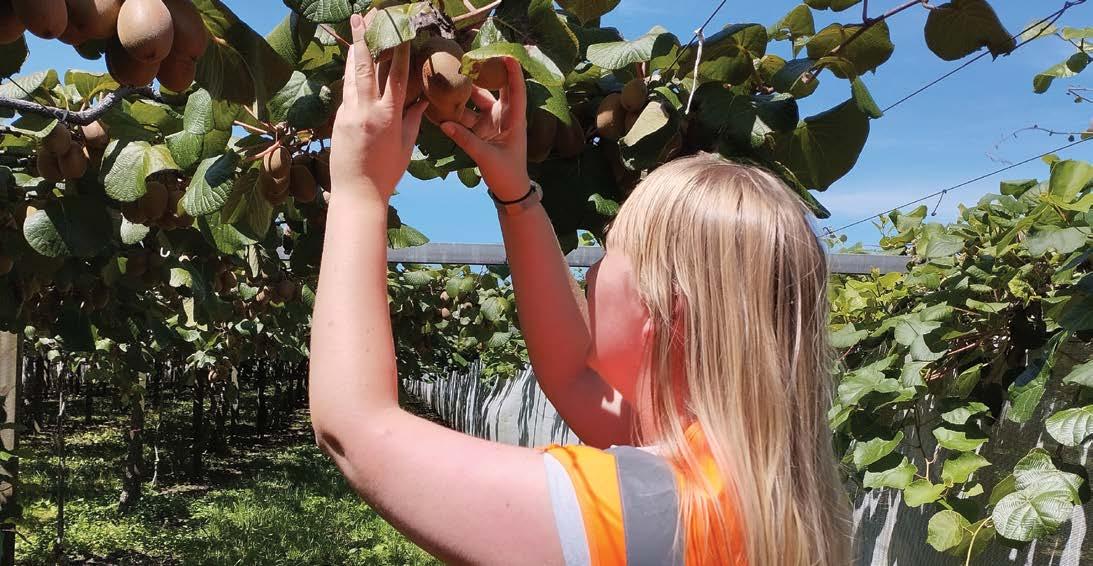
Climate change trigger for sustainable, resilient land use
Increases in extreme weather events are highlighting the need for sustainable and resilient forms of land use, says
Phoebe Scherer, technical laboratory manager at Apata Group Limited.
Elaine Fisher
“Since I began working in horticulture six years ago, I don’t think the North Island has experienced what could be classed as a ‘normal’ growing season. There have been droughts, floods, cyclones and everything in between.
“Growers have faced so many curve balls that they need resilience built into their businesses. They have got to have sustainable and resilient portfolios of land use. It is likely that climate change will result in changes in land use.”
Phoebe joined Apata in January this year, after six years with Fruition Horticulture in Tauranga.
“We worked with growers of kiwifruit and avocado in the Bay of Plenty but also with orchardists from the Far North to Wellington. Some of our work included feasibility studies looking at land use most suited to particular areas, including potential dairy conversions in Taranaki which has similar volcanic soils to the Bay of Plenty.
“We used to joke at Fruition that we may be out of a job in the Bay of Plenty and in 20 years, Christchurch would be the best place to grow kiwifruit.”
Phoebe started at Fruition Horticulture as a summer student after returning to New Zealand from her OE and was subsequently offered a full-time role as a consultant.
CLIMATE SPECIAL 44 The ORCHARDIST : MARCH 2024 YOUR INDUSTRY
Phoebe Scherer is technical laboratory manager at Apata Group Limited

Crop damage from wild animals was one of the challenges during Phoebe’s time as a volunteer in Namibia
Her new role at Apata involves overseeing the work of the company’s laboratories at the Katikati Turntable Hill Road and Te Puke Mends Lane sites. In mid-January the teams were gearing up for the kiwifruit harvest through crop maturity monitoring, crop estimation including fruit size and reject rates, providing data to growers and the harvest and post-harvest teams.
We used to joke at Fruition that we may be out of a job in the Bay of Plenty and in 20 years, Christchurch would be the best place to grow kiwifruit
Horticulture is not the career Phoebe planned when she studied for a Bachelor of Science (Hons) Biology and Anthropology at the University of Auckland, but now she thoroughly enjoys the industry. “I’d recommend a career in horticulture to young people – women especially because there is so much variety and so many different jobs from outside in the orchard to management, to business or the technical side.
“This is a growing and evolving industry which will only keep getting better with the move to precision horticulture. It’s not a solely male-dominated industry as people may think. There is a really great developing support network (Women in Horticulture) for women coming into the industry. I have a network of friends and mentors I can rely on.”
Born in New Zealand, Phoebe and her family moved to the United Kingdom when she was three, returning to Tauranga around seven years later. “I went to Aquinas College in Tauranga where I was able to pursue a lot of different interests in science.
This is a growing and evolving industry which will only keep getting better with the move to precision horticulture
“I was in the New Zealand Biology Olympiad training group and although I didn’t go to competitions I had the chance to experience what it is like to study at a university. I had a trip to a London International Youth Science Forum with lots of lectures and workshops and got to go to CERN (the European Organisation for Nuclear Research) to see the Large Hadron Collider, the most powerful particle accelerator ever built. That was amazing. How many 17-year-olds get to see how scientists probe the fundamental structure of particles that make up everything around us?”
Phoebe’s love of science and the natural world was fostered by her parents who encouraged her curiosity. “I read a lot and remember watching David Attenborough and National Geographic programmes and decided I wanted to do science.”
After finishing university, Phoebe spent four months, on two separate occasions, as a volunteer with the Naankuse Foundation in Namibia, helping with research activities into mitigating human-wildlife conflict.
“Apart from tourism, Namibia’s biggest industry is farming and it’s pretty hard if there are wild animals which eat your livestock and crops.
“Some of the solutions included putting radio tracking collars on leopards which were being persecuted by farmers who thought they were preying on their livestock. The tracking showed this was generally not the case.”
The solution to preventing elephants eating crops was even more innovative. “Elephants have really sensitive taste buds in their trunks so planting chillies around vegetable gardens and crops worked.”
To join Women in Horticulture, visit www.unitedfresh.co.nz/women-in-horticulture and follow us on Linkedin.
The ORCHARDIST : MARCH 2024 45 YOUR INDUSTRY
SUMMERFRUIT UPDATE
A far better season for most
Kate Hellstrom, chief executive Summerfruit NZ
For most growers, particularly those in Central Otago, the 2023–2024 season has heralded a return to better times.
The weather – while not as hot as some predicted –has ensured the fruit looks good and is great tasting. Furthermore, volumes have been up, except in the Hawke’s Bay where it will take another few seasons for our remaining growers to recover.
Industry-led labour attraction campaigns continue to bear fruit, particularly in Central Otago, with its unique backpacker tourist attractions. Our industry is also lucky that the harvest takes place when university students are looking for work, before they resume their studies.
Timing-wise though, the lateness of Chinese New Year this year – 10 February – meant that most growers had already finished their crop. However, by 10 February, cherry exports had already surpassed last year’s volumes.
This season, Summerfruit NZ ran a domestic, social media promotion – ‘eat summer, make memories with summerfruit’. The campaign targeted the socioeconomic consumer groups most likely to buy summerfruit with a little bit of prompting. While it was hard for growers to see the campaign – because growers were not being targeted – I am confident the campaign increased interest in summerfruit amongst the targeted consumer groups. The assets developed for the campaign can also be used in future seasons.
Over the summer, the new coalition government has been coming up to speed. Associate Agriculture Minister, Nicola Grigg, has visited the Hawke’s Bay. Nicola has been assigned responsibility for horticulture. At the moment, she is on parental leave but her office is still active, supporting Agriculture Minister, Todd McClay. Working with Horticulture New Zealand, we are ensuring the new government is aware of the industry’s wider issues – around land, freshwater, climate change, research and development, access to agrichemicals, and a skilled workforce.
The new government has a busy three years ahead of it. Reform of the Resource Management Act and work in the freshwater space are obvious priorities. In terms of the economy, New Zealand appears to be behind the rest of the world in terms of a recovery from high interest rates and low demand.



While horticulture is seen as the darling of New Zealand’s primary sector, we are experiencing across the board challenges that limit our potential. For summerfruit, while predicted future weather patterns will be good for the industry, we will still need to contend with a greater number of adverse weather events. That is a sobering thought, just over a year on from Cyclone Gabrielle, when the new government has committed many more millions to Hawke’s Bay and Tairāwhiti’s recovery.
Growers grow because they are passionate and proud of the healthy food that they produce. However, their businesses must make a profit. While there have been murmurs about the high price of summerfruit this season, grower costs continue to increase and it is only the final 20 percent of the crop that provides the average grower with any profit.
Summerfruit NZ’s objective is to increase grower viability. While it is good that most growers have had a better season, we know that the industry has a way to go before it is viable again for many growers.
That is the message we are taking to the Beehive, as the new government engages with the horticulture industry and plans out its next three years in power.
46 The ORCHARDIST : MARCH 2024 YOUR INDUSTRY
A targeted social media campaign has increased domestic demand during the summer
Officials experience growers’ passion, pride and pain
Thirty-five central and local government officials visited Lewis Farms and Woodhaven Gardens, two major Horowhenua-based, family-run growing businesses, in early February.
The Orchardist staff
The pilot cross-pollination day was part of the Aotearoa Horticulture Action Plan. The aim of the day was to allow officials to hear directly from growers about their operating environment, views, concerns and ideas – recognising that it is difficult for officials to travel to the regions to meet with those whom their policies and regulations affect.
“It’s good to get out of the echo chamber of Wellington,” said one senior official, while another remarked that they wanted to better understand the roadblocks facing growers and “meet these people, given I make policy for them”.

“I would like you to understand how dangerous the precipice we are sitting on is, in terms of food security for fresh vegetables in this country.”
Jay says the vegetable industry has played by the rules: reduced its environmental impact and increased its social licence. He is yet to meet a vegetable grower in New Zealand that says the industry shouldn’t be held to account and grow in an environmentally sustainable manner.
The strongest feedback from the group was a realisation of how many stressors growers have to deal with.
The officials came from the Ministry for Primary Industries, Ministry for the Environment, Ministry for Business, Innovation and Employment, Environmental Protection Authority, and Horizons Regional Council.
Lewis Farms is a fourth-generation family business, famous for its asparagus and now, for its strawberries. Cam Lewis told the group about the workload growers face.
“One of the things I do every Christmas Day is I work out how many days I have worked without a day off and it was 122 days, seven days a week last year, and it’s just too hard. But you can’t half do growing. You either do it properly or not at all.”
Catherine Lewis, a self-confessed ‘compliance nerd’ who takes care of the businesses’ 11 audits, highlighted the duplication and inefficiency she faces, such as being asked by multiple government departments for the same information and at busy harvest times.
Woodhaven Gardens now grows 10 percent of New Zealand’s fresh cut greens. Jay Clarke of Woodhaven Gardens didn’t hold back, as he sought to ensure officials fully understand the challenges facing vegetable growing in New Zealand, under current regulatory settings.
“Small-medium scale commercial fresh vegetable production operations in New Zealand are becoming increasingly difficult to sustain,” an official noted after the event. “Government and other regulatory agencies need not make things harder than they need to be.”
For many of the officials, the experience highlighted the drivers growers have for being part of the horticulture sector, including their moral obligations regarding employment, community development and national food security.
“Businesses face recurrent audits amid thin profit margins, urging efficient processes for sustainable operations. Vegetable growers seek equitable government support for food security crops over exports. I’ll prioritise this concern in our research and policy analyses.”
Feedback from the participants indicates the crosspollination day proved successful in building officials’ understanding of the horticulture industry.
Anna Rathé, Aotearoa Horticulture Action Plan programme manager, reflected that “the day was a great success. Listening to the exchange between growers and officials I’m certain that the field trip provided useful exposure to the industry and generated some excellent, robust discussions.”
The ORCHARDIST : MARCH 2024 47 YOUR INDUSTRY
35 Central and local government officials visited Horowhenua
It’s your industry and your vote
Karen Morrish : NZ Apples and Pears chief executive
Road trips and legislation are an unlikely combination, but an important one for me this month, as I hit the road to meet growers around the country to discuss the renewal of the Commodity Levy Order for apples and pears.
The apple and pear Commodity Levy Order is what legally mandates NZ Apples and Pears (NZAPI) to collect a levy from commercial apple and pear growers to fund industry support services. Every six years we are required to renew this legal status as the levy collector, and as it was last renewed in 2018, 2024 is time for renewal.
A bit of history helps explain why and how we have this role as the commodity levy holder for apples and pears. In 1990, the government introduced the Commodity Levies Act to provide a legal basis for primary industry groups to impose a levy for the funding of primary industry activities.
This is because it was recognised that there is a need, and a cost, for the support and services the industry requires to function and grow in New Zealand and to engage and export around the world. Then, under the Commodity Levies Act, the Commodity Levies (Apples and Pears) Order, was established to mandate the operation of NZ Apples & Pears as the levy collector and therefore to act as the industry body for pipfruit.
Today, more than 30 years on, our Commodity Levies Order continues to be the foundation of what we as an industry do, for our industry. The levy provides growers with a wide range of services from market access to crop protection, biosecurity, extension, workforce and research and development.
Beyond service provision, what the levy order does is bring our industry together, and together we are strong. Together we are many things – together our voice is loud and
Online Orchard Irrigation Supplies
Call our experts 0800 130 905 www.irrigationexpress.co.nz

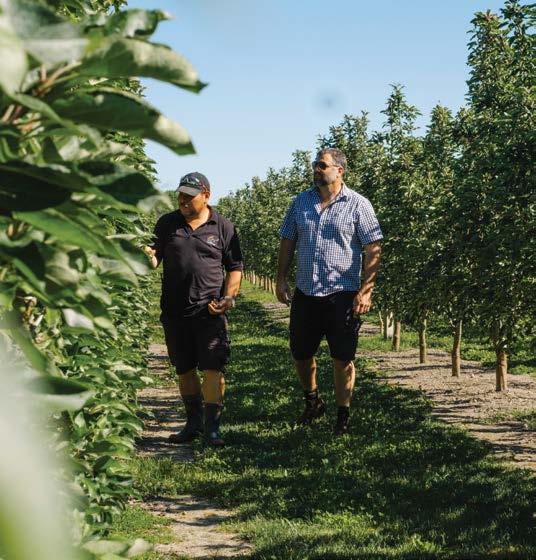
clear, we are efficient and effective, and most importantly, together we grow the best apples in the world.
So, let’s get together to discuss our levy order. We are holding meetings in growing regions this month. I realise this is a busy time of year, so meetings are combined with an update on our recent strategic review – which aligns with the levy order renewal.
If you can’t attend a meeting, please head to our website, join an online meeting and have a read of the consultation document: applesandpears.nz/Commodity_Levy.
Every vote counts – regardless of how big or small your business is, this is your industry and your vote. Voting is open from 9am Monday 8 April to 12 noon Friday 3 May 2024, both online and by post.
Feel free to also get in touch with me directly on 027 278 4884 or karen@applesandpears.nz
This is your levy order, please do get involved and remember to vote!
NZAPI UPDATE
48 The ORCHARDIST : MARCH 2024 YOUR INDUSTRY
NZ Apples and Pears will be meeting with growers to discuss the levy this month. Photo by Florence Charvin
SPECIAL
Building sustainability into orchard systems
Orchard block redevelopment provides the ultimate tool for progressive improvement.
Carl O’Brien : AgFirst Consultants Hawke’s Bay
Each block is assessed on its own merits and is subject to a large sphere of influence across the business – meaning it can essentially be used as a micro business in its own right to evaluate, implement and review improvements. Not many other industries or businesses have a such a ready-made pathway for change.
Primary producers are facing a range of pressures to
15, 50, 100 years and beyond. It is the continuous drive to understand how economic, environmental, social, and business governance mechanisms (and pressures) interact, and what decisions can be made that reflect the overarching business purpose across all these spheres. Research has demonstrated where a business integrates sustainability into their operations, they typically
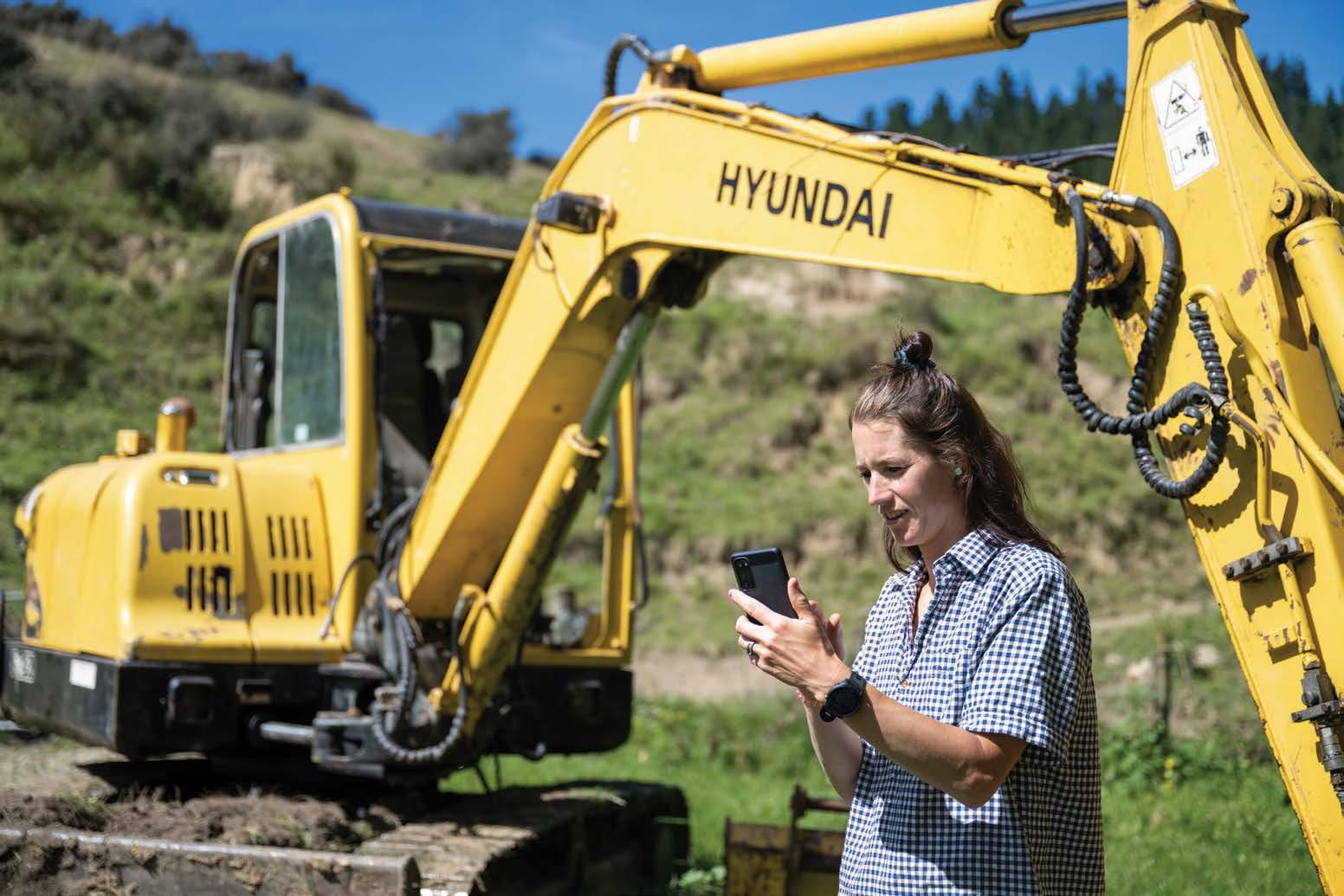

CLIMATE
The ORCHARDIST : MARCH 2024 49 TECHNICAL
Soil maps should have been reviewed in the detailed design. We overcame the challenge given the readily available wood posts could quickly be sourced. Lessons learnt for the next block to ensure we check soil maps in advance. Additional reviews scheduled at the completion of first growing season and 2-yearly to track tree growth and variety performance.

Block 1 showing decline in yield. No longer profitable given the pruning and thinning requirements for that variety.
IDENTIFY
EXECUTE
We completed redevelopment in the next planting season, planted the selected variety and rootstock and installed subsurface dripper irrigation. We used steel posts for the bulk of the block however an area of gravelly soil was encountered and posts in this area had to be shifted to wood.
Block 1 requires redevelopment. A cost benefit analysis of varieties includes existing variety matrix, rootstock, and market trends. Analysis identifies grafting isn’t suitable. We can improve irrigation efficiency if full replant undertaken. Replanting allows us to introduce an early maturing variety to improve market penetration. Steel posts will reduce the development cost and are readily recyclable.
Progressive improvement – the ‘How’
Life expectancy of a productive orchard can be up to 40 years, however a typical programme assumes variety matrices will change within 15-20 years. As such, progressive redevelopment is required to keep the economics of the business ahead, particularly against declining yields once trees begin to age.
Conventional models suggest redevelopment should focus on 6% of the orchard footprint each year where underperforming varieties are replaced. At each redevelopment cycle (illustrated in Figure 1 ), an orchard has remarkable scope to look at the full suite of social, environmental, and economic spheres impacting its business.
These parameters include:
• Variety matrix and market penetration
• Market trends and variety performance (returns)
• Labour efficiencies across peak workloads (i.e. thinning, harvest, pruning)
• Orchard growing system structure
• Irrigation application coverage and efficiency
• Biodiversity
• Pest and disease resistance, pressures, and spray requirements
• Yield drivers and internal rate of return, including time from redevelopment to full production and strengths of grafting against replanting
• Material requirements and lifecycle assessment of alternatives, and
• Limitations on productivity from the previous system (i.e. drainage, soil quality, shading etc).
Figure 1 Continuous improvement using an orchard redevelopment cycle
ER V I EW
PL A N
50 The ORCHARDIST : MARCH 2024 TECHNICAL
In my experience it is unusual and unlikely that block redevelopment would result in wholesale change of all components of a business operation, however it is commonly used to reflect wider dynamics such as a push for environmental sustainability.
Expect challenges and revisions within continuous improvement
With change comes inevitable setbacks as the most efficient mechanisms of working the identified change into an existing system. Setbacks should not be viewed as failure, but utilised to make further improvements into the future using a continuous improvement cycle as illustrated (Figure 1 ).
Sustainability is the continuous drive to understand how economic, environmental, social, and business governance mechanisms (and pressures) interact
Don’t forget to measure change against traditional performance. Any comparisons should be made on the full spectrum of price, availability, installation speed, failure rates, recyclability, and environmental footprint.
Summary
The journey in orchard systems should focus on obtaining the highest optimal yield, at the highest obtainable quality, produced with the least interventions possible. The lower the intervention requirements, the lower the costs associated with the product (economic, social, and environmental).
As Charles Dickens noted, “The best way to lengthen out our days is to walk steadily and with a purpose”.
References
Clark, G. L., Feiner, A., & Viehs, M. (2015). From the Stockholder to the Stakeholder: How Sustainability Can Drive Financial Outperformance. SSRN.
Spindler, E. A. (2013). The History of Sustainability: The Origins and Effects of a Popular Concept. Sustainability in Tourism: A Multidisciplinary Approach, 9.
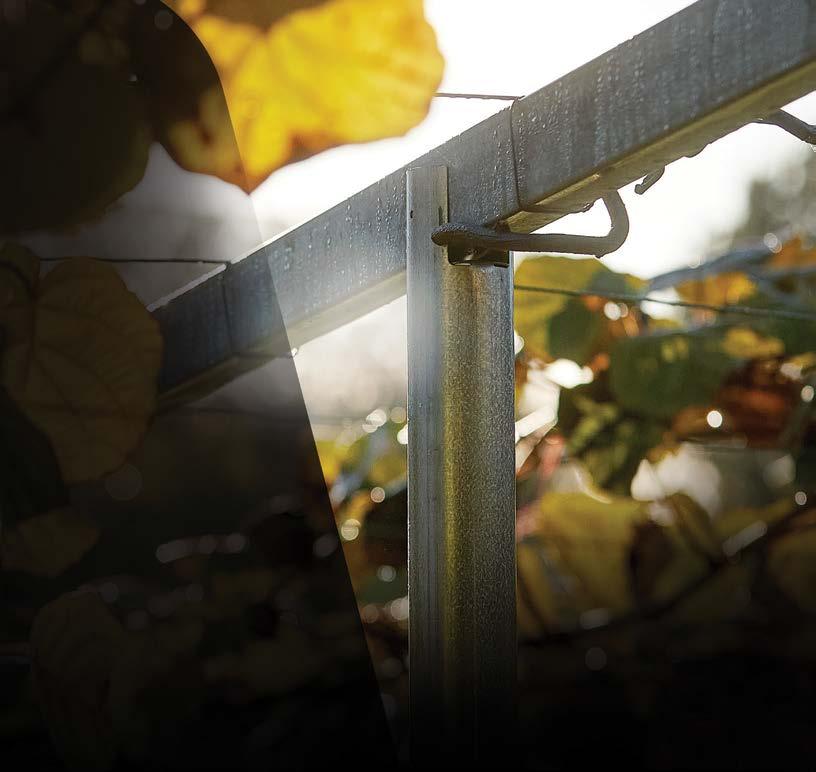
For all your Kiwifruit development needs GROW WITH AG-STEEL ORDER ONLINE | agsteel.co.nz • Ag-Beam • Ag-Stringing Pole • Ag-Net Pole • Ag-Brace • Ag-Tripost • Ag-Support Post The ORCHARDIST : MARCH 2024 51 TECHNICAL



CASE STUDY: MATERIAL SELECTION FOR ORCHARD SUPPORT STRUCTURES
Carl O’Brien : AgFirst Consultants Hawke’s Bay
A common topic for environmental sustainability is the material selection for orchard support structures.
The three primary options with good market penetration currently are treated wood, steel, and pre-stressed concrete. Using these orchard structure support materials as a case study, we’re going to look at how sustainability can be tailored into decision making at a macro level.
Conventionally, treated timber posts have been the material of choice due to affordability, availability, and reliability. However, in recent times concrete and steel alternatives have become available and present viable alternatives within orchard systems.
Anecdotally, early adopters of concrete posts had issues where the manufacturing specifications did not provide enough stress testing and subsequently, the concrete failed on installation. Similarly, steel posts encountered some issues with specific soil conditions (high gravel and boulder content) causing the steel to bend and skew when installing, and not obtain sufficient structural integrity.
Timber posts however are not without failures in challenging soils, and inherent defects also cause failure from time to time. Determining factors of availability, installation methods
and costs, recyclability and other available materials options are detailed below to look at what are the driving factors that promote one above the other.
Availability and use
AgFirst industry experience suggests 70 percent of pipfruit orchardists have a clear preference for wood and utilise this as their primary material choice because of that preference. When queried further, the majority of these understand there are issues with intermediate posts breaking under strain, or not being able to obtain long enough posts to support a structure capable of delivering a 100t/ha apple crop.
AgFirst industry experience suggests 70 percent of pipfruit orchardists have a clear preference for wood
Reflecting on that, orchardists have stated steel is the clear future option for meeting a production excellence target as it is viewed as a consistent, long-life product, yet why has it not gained primary preference or market share?
Treated timber posts have been the go-to choice for orchard structures, but scrutiny of their environmental impact is increasing
Steel supports are now commonplace in kiwifruit orchards and also present benefits for other crops
Concrete posts have become available in New Zealand, creating a long-lasting and environmentally friendly alternative
52 The ORCHARDIST : MARCH 2024 TECHNICAL
Local suppliers are available for wood, concrete, and steel posting options and lead-in times are noted to be dependent on number, size, and strength requirements. A review of orchard development supply companies confirms all three materials are available, but there is a clear indication wood is more readily available as an off-the-shelf option whereas concrete and steel likely to be supplied to order.
Costs and installation methods
Specific costs will be dependent on the scope and scale of redevelopment (and any specific supplier agreements) with costs for purchasing steel posts being the cheapest option, followed by wood and concrete the most expensive. That said, concrete generally requires the least maintenance and has the longest design life out of the three primary options.
Any company looking for measures to reduce their environmental footprints can use a shift in materials to reduce this impact
Prestressed concrete, timber, and steel posts are all able to be machine driven on site and are installed in a similar manner. The lightweight aspects of steel and ability to have pre-drilled support mountings means it is the fastest to install, closely followed by wood. However, the weight of pre-stressed concrete means mechanical lifting assistance is necessary for placement, slowing its installation speed.
Leaching and soil contamination
Soil testing where Chromated Copper Arsenate (CCA) treated posts have been installed in the ground generally results in a 100mm halo surrounding the post where arsenic becomes significantly elevated. Density of post placement depends on the system and crop however most systems are expected to fall within a range of 250 – 1,000 posts / ha and an average in the region of 400 – 500 posts / ha. Bioavailability assessments confirm the risk profile is low in terms of human health, however the presence of CCA leaching can present implications for any proposed shift from a conventional to organic system or for future development of sites where they may become urban. Similarly, any company looking for measures to reduce their environmental footprints can use a shift in materials to reduce this impact.
Concrete does not cause any leaching issues, however where galvanized steel is used, some increases in zinc may be expected. Zinc is less hazardous than arsenic and would be present in much lower concentrations.
Recyclability
Steel presents an endlessly recyclable material, able to be reconstructed, repaired, or repurposed with many locations receiving damaged or broken steel across the country. Similarly, concrete is recycled via crushing and use as an aggregate across a range of purposes and a number of contracting firms and transfer stations readily receiving concrete for crushing and aggregate use.
In contrast, CCA treated posts are the most difficult to recycle. Where broken or damaged, they can be cut down and reused for alternative purposes such as farm fencing where sufficient length is available, however historically treated timber waste was only able to be sent to landfill. Recent changes via the Waste Minimisation Fund has enabled treated timber to be chipped and used by Golden Bay Cement for biofuel in the production of its cement products. This, however, requires a large volume of material and locations for collecting wood waste are limited at this stage.
Wider alternatives
Less explored options for support structures include plastic composite materials and hardwoods. These have not been widely adopted due to cost and availability. Plastic composites are becoming more and more common in agricultural undertakings as the strength required is greatly reduced. In contrast, hardwoods are not produced as widely, and I understand there is no domestic market currently identified. With prices generally between 2 and 5 times the rate of typical CCA, and a much lower availability, hardwoods are not expected to be a viable alternative at the current stage.
Orchardists have stated steel is the clear future option for meeting a production excellence target
Making a decision
Breaking down what we know about the available options for support structures, does one option excel above all others? No, it doesn’t.
Where availability and speed of installation are paramount, an orchardist would likely select treated timber to ensure a redevelopment can be completed within a planting season. Where high winds are present requiring addition strength, rationale would likely tip towards steel. Similarly, where an orchardist wishes a structure to last for 100 years through a few cycles of varieties, wishes to minimise maintenance and lower the environmental impact on soil and water, concrete meets these requirements.
The best and most sustainable option is the one that meets the business purpose and plan where site conditions, life expectancy, price, availability, speed of installation, environmental impact, and recyclability are assessed.
The ORCHARDIST : MARCH 2024 53 TECHNICAL

Adapting New Zealand’s biosecurity system
Global climate change is altering regional climates and the frequency of adverse weather events is increasing. Across the globe, this is ramping up pressure from pests and diseases on crop producers.
Alex Bisson : HortNZ risk policy advisor
Prolonged drought conditions cause water stress to plants, and water logging from heavy rains or floods also triggers similar physiological plant responses. Events such as these reduce plant resilience and suppress plant immunity, which leads to poor plant health and inflated damage caused by pest infestations or infectious plant diseases.
Increases in average temperatures and stronger fluctuations in rainfall are furthering the global spread, development, and prevalence of disease-causing organisms such as viruses, bacteria, fungi, and insect pests.
For example, climate warming has already increased the abundance and impact of soil-borne fungal pathogens in areas that were not previously affected.
Andy Richardson, agronomist and managing director at Allium & Brassica Agronomy in the United Kingdom says
that “the 10 warmest years recorded since 1884 in the United Kingdom have all occurred from 2003. And 2022 was the warmest year on record.”
Subsequently, fungal-mediated disease outbreaks in onion and brassica crops have increased significantly.
“Fusarium basal rot, a soil-borne fungal disease, affecting bulb onions, only caused isolated minor issues before 2010,” Andy says as an example. “Warming soil temperatures have significantly increased disease incidence, and over the past 12 years Fusarium has become the number one cause of loss in stored onions in the United Kingdom, and other parts of northern Europe.”
While Fusarium basal rot has not been observed on New Zealand crops and the causative fungus (Fusarium oxysporum f. sp. Cepae) is not known to be present here,
54 The ORCHARDIST : MARCH 2024 TECHNICAL
Western flower thrips and onion thrips are already in New Zealand. Warmer temperatures provide more favourable conditions for thrips to establish across wider regions
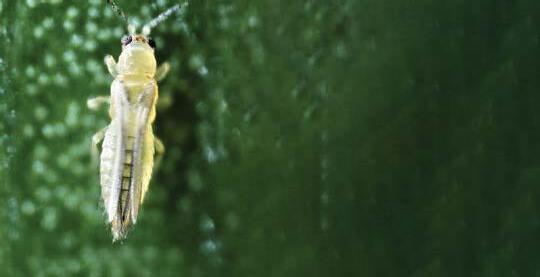
Thrips characteristics
1-1.3mm: With their tiny size, thrips can easily hide out of reach of insecticides and out of sight
7700 species: Only 1% of thrips (Order Thysanoptera) are known harmful to crops
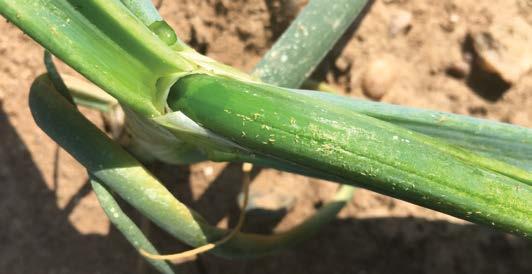
this example demonstrates how quickly a minor nuisance can become a major disease issue as the climate changes.
Warmer average temperatures also provide more favourable conditions for invasive insect pests like thrips to establish and develop across wider geographical regions.
“Thrips enjoy hot, dry weather and the speed of their lifecycle (like most insects) is determined by temperature,” Andy says. “Increasing temperatures by as little as 1°C can have a significant effect on insect numbers and overall pest pressure.”
Some particularly harmful thrips species like the Western flower thrips (Frankliniella occidentialis), onion thrips (Thrips tabaci) and melon thrips (Thrips palmi) are present in many countries, with Western flower thrips and onion thrips already in New Zealand.
Many thrips species have historically had more limited geographical distributions but this is changing as climatic conditions in other places become more favourable for thrips development and establishment. In the future it is likely that more thrips species may be capable of establishing in the New Zealand climate.
On behalf of New Zealand’s growers, Horticulture New Zealand advocates for high biosecurity standards to protect our horticulture industry. We engage with a variety of government departments with the aim to ensure that our biosecurity system is agile and capable of adapting to future challenges such as climate change.
On a weekly basis, HortNZ’s Risk Policy team works with Biosecurity New Zealand (part of the Ministry for Primary
UK ONION CROP 2000-2023 –
AFFECTED BY FUSARIUM
Industries) on the import requirements for plants, plant products and fresh fruit and vegetables. We try to find a balance between protecting your existing crops from the arrival of new pests and diseases while enabling our sector to bring in the germplasm (seeds, nursery stock etc.) that is required for horticulture to adapt and thrive into the future. As it is not possible to prevent everything from entering the country, HortNZ is also involved in setting the direction of government-industry agreements for biosecurity responses so that New Zealand is best prepared to control any highrisk pests or diseases that do make it to our shores. While we engage with the government on pan-sector challenges, we’d like to encourage all growers to play your (very important!) part in New Zealand’s biosecurity system. Be vigilant and monitor your crops for unfamiliar pests and disease symptoms. If you spot anything unusual, be sure to report it via the MPI pest and disease hotline or the Find-A-Pest app.
If you spot it, catch it, snap a photo and report it!
• Use the Find-A-Pest app if you find anything suspicious: www.findapest.nz.
• Call the Ministry for Primary Industries’ pest and disease hotline 0800 80 99 66 or use the online reporting form.
% CROP
2002 2003 2004 2005 2006 2007 2008 2009 2010 2011 2012 2013 2014 2015 2016 2017 2018 2019 2020 2021 2022 2023 0 1 2 % Bulbs Affected 3 4
The ORCHARDIST : MARCH 2024 55 TECHNICAL

Northland’s changing climate
Georgina Griffiths : Meteorologist, MetService
Northland is warming
Northland has always been tagged as the ‘winterless north’ due to its mild winters and often benign winter climate, relative to the rest of New Zealand.
Climatologically, Northland sits well north at 35°S, is surrounded by relatively warm seas, and the ‘subtropical ridge’ (high pressure zone) commonly sits across Northland during winter (June–August). Air frosts are rare for Northland (with many years recording none), while ground frosts remain infrequent.
Against a background of warming (due to climate change), Northland has seen an upward trend in observed temperatures. The mean annual temperature at Whangārei Airport has increased from 15.8°C in the 1970s, to 16.7°C since 2010. Under climate change, annual temperature in Northland is projected to increase further, by up to 1.1°C by 2040 and up to 3.1°C by 2090.1
In line with the rest of New Zealand, the tails of the temperature distribution are already showing signs of being disproportionally affected. By that we mean, frosts in Northland are already rare, but climate change modelling expects frosts to vanish almost entirely.
Northland has always experienced a decent number of summer days with temperatures exceeding 25° Celsius, but under all warming scenarios, the so-called hot day* counts dramatically increase. Under climate change, summer is the season likely to warm the most in Northland.1
Figure 1 shows Whangārei observations from the last 56 years, with counts of summer days (December–February) hitting or exceeding 25° Celsius. The decadal average ranges between 26 and 29 days per annum prior to 2010, after which there is a jump to an average of 39 days per annum.
Northland rainfall is highly volatile, and always will be
Figure 2 shows the rainfall accumulation at Whangārei Airport from 1948 to 2023, noting that there are some years of missing data within this period. The extreme weather of 2023 (red line) is clearly visible, being the wettest year on record at this rain gauge. Other notably extreme wet years are 1960, 1956, and 2022 (green line).
CLIMATE SPECIAL

Flooding and ground water impacts in 2023 were exacerbated by the extreme rainfall of the year before (2022). What really stands out is the large variability in rainfall that Northland experiences from year to year, literally from drought to deluge and back again.
Given the large volatility in Northland rainfall overall, it may come as no surprise that climate change projections for Northland are uncertain,1 with a large span of outcomes modelled. That this, projected rainfall changes due to global warming are small for Northland prior to 2040, although there is a tendency toward a drier spring.
By 2090, however, the modelling shows significant spring rainfall reductions (and associated increase in drought in prone areas), and an increase in summer to autumn rainfall. By 2090, extreme rainfall events are likely to increase for Northland, due to increasing moisture availability in a warmer atmosphere. However, the future impact of Tropical Cyclones for Northland remains uncertain.
Looking ahead – autumn projections
The 2023–2024 El Niño has already peaked in the tropical Pacific Ocean and is now easing. The climate system should return to neutral levels during autumn 2024.
The long-range forecast using the ECMWF (European Centre for Medium-Range Weather Forecasts) ensemble (based on 7 February data) predicts that the Northland ridge will be slightly stronger than usual this autumn, and there should be a higher frequency of northwest winds over New Zealand than normal. The models intersperse these northwesterly winds with a run of fairly settled weather under a High around April, give or take on timing.
In line with these weather patterns, a slightly drier than usual autumn is forecast for the Northland region, with above average to well above average autumn temperatures.
For the record, we can never rule out a late burst of tropical activity in the Coral Sea area around Fiji, spawning a ‘wild card’ late Tropical Cyclone to bring humidity and moisture down towards the upper North Island – but the risk is much lower than in 2023.
With respect to winter (June–July), El Niño is forecast to remain in its neutral phase, or possibly start to trend towards La Niña in the tropical Pacific Ocean.
56 The ORCHARDIST : MARCH 2024


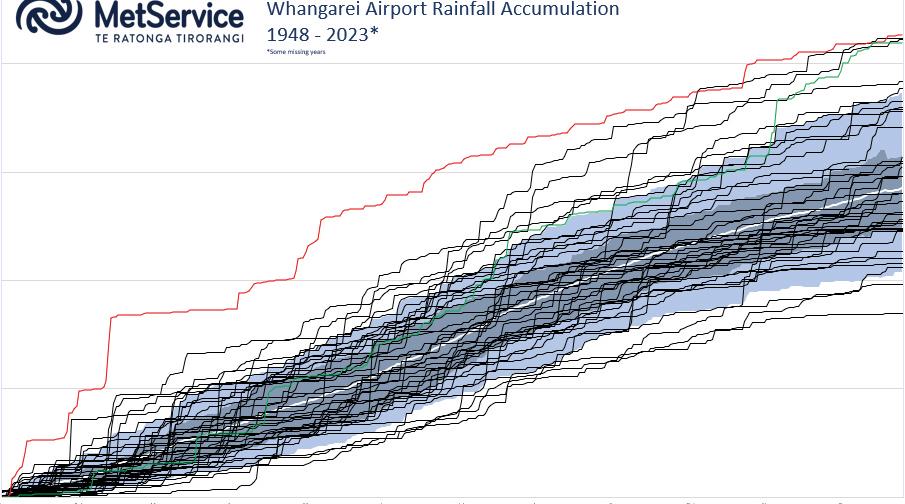
the green
is the 2022
1 January to 31 December, for the period 1948–2023.* The red line is the 2023 rainfall
The 10th/90th and 25th/75th percentiles are shaded light grey and dark grey, respectively. The
is the
*Note: there are some years with missing data in this period. Line shows the
Regardless of El Niño Southern Oscillation (ENSO), New Zealand winter weather maps will be driven by the usual battle between the Tasman Sea and the Southern Ocean weather systems vying for dominance. If the Tasman Sea becomes dominant, the North Island will typically see a warmer but wetter than usual winter. If the Southern Ocean fires up, the South Island would typically experience a wetter and windier than normal winter.
As always, you should keep up to date with the MetService long-range forecast at http://metservice.com/rural/monthlyoutlook, or ask us questions on the MetService Facebook or Twitter feeds.
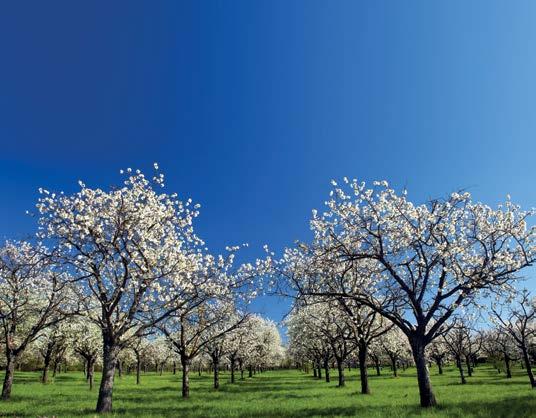

MetService Update Sponsored by:
Figure 1 Count of Whangārei Airport summer days with maximum temperature >=25°C. Blue dashed lines indicate an average decadal count prior to 2010 ranging between 26°C and 29°C respectively; the red dashed line shows the average count post 2010 (39 days)
Figure 2 Whangārei Airport rainfall accumulation from
accumulation,
line
rainfall accumulation.
thick white line
long-term average accumulation.
average count post 2010 (39 days)
1968/69 1971/72 1974/76 1977/78 1980/81 1983/84 1986/87 1989/90 1992/93 1995/96 1998/99 2001/02 2004/05 2007/08 2010/11 2013/14 2016/17 2019/20 2022/23 60 50 40 30 20 10 0 Number of Days Summer days at Whangārei* 1967-2023 Whangārei
*Temperatures greater than 25°C 57 2000 1500 1000 500 0 Jan Apr Jul Feb May Aug Oct Mar Jun Sep Dec Nov *Some missing years 2023 2022 The ORCHARDIST : MARCH 2024 57
1. Pearce, P.R. (2017) Northland Climate Change Projections and Impacts. NIWA Client Report for Northland Regional Council, 2017027AK. * Acknowledging that nowadays, no one in Northland would think of 25°C as a hot day!
* Airport Rainfall Accumulation 1948-2023*
Genesis strengthens their commitment to Kiwi growers
In the dynamic and competitive business of fruit tree nurseries, the journey to becoming a world-leading grower demands more than raising quality trees. It requires a strategic approach, comprehensive knowledge and a dedicated team of specialised employees.
The recent additions to the Genesis Nurseries team, Dean Smith, Dave Greer and Jamie Hall, who join existing chief executive Hayden Green, bring a wealth of experience and a shared vision of supporting growers in their journey to becoming world-leading.
With the expansion of the management team, Hayden believes Genesis is well equipped to contribute to orchard success. “We want to be more than just a nursery, we want to be a dynamic force that stays ahead of industry trends. A team that constantly explores new technologies, sustainable practices and cutting-edge horticultural methods. By embracing innovation, we not only enhance the quality of our trees but strengthen our links with IP (intellectual property) owners and breeders, providing our growers with the knowledge to stay at the forefront of the fruit production industry”.
Taking on the role of business development and intellectual property manager is seasoned specialist, Dean Smith. Previously leading Hawke’s Bay Fruitgrowers’ Association, Dean understands the importance of collaboration and communication in achieving successful and sustainable commercial outcomes.
“During my time advocating for growers, I gained a deep appreciation for the challenges they face, from accessing capital to navigating workforce constraints, regulatory hurdles, market fluctuations and extreme weather events,” Dean explains.
“I’m also very aware of the long planning horizons and the significant investment with planting, and plan to bring this grower perspective to support our service delivery.”
Similarly, Dave Greer, the newly appointed general manager operations brings a multifaceted skill set to Genesis, combining his expertise in pest, disease and risk management planning (acquired through global experience in vineyards), and nine years of irrigation engineering, with his experience in managing labour supply, assisting the Hortus management team to establish the company in the North Island.
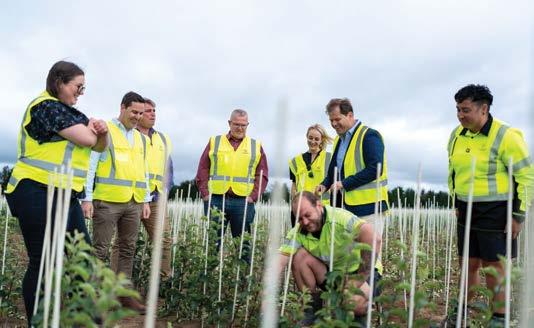
While growing top-quality trees is paramount for Dave, “building a great culture and team that can develop up the ranks” is a strong priority.
Completing the team as safety, people and capability manager is Jamie Hall. With his strong roots in the field and understanding of the regional dynamics, Jamie is equipped to be a crucial player within the Genesis team.
Jamie says his ability to assess the team’s current skills and identify gaps will mean “staff will not only remain safe at work, but will allow me to provide further training and skilled labour when required. Overall, I want to ensure all labour is working towards producing the best product for our growers”.
As the 2024 season ramps up, the strategic additions to the Genesis Nursery team will strengthen their commitment to staying ahead of industry trends and supporting growers on their journey to becoming world-leading.
To learn more about Genesis and their team, you can visit their new website: https://gnl.nz
58 The ORCHARDIST : MARCH 2024 WHAT’S NEW
New management team onsite at Matapiro, Hawke’s Bay
World Travellers Motueka announce launch of RSE Travel Management portal
World Travellers Motueka has been deeply engaged with the Recognised Seasonal Employer (RSE) scheme since its inception in 2007.
Over the years, we have established ourselves as the premier RSE travel agency, serving 130 RSE employers and over 12,000 RSE workers.
As our roster of employers grew, our spreadsheets became increasingly unwieldy.
We realised we needed to ditch spreadsheets and create a system where all information could be easily accessed on a single screen by our entire team. This system had to be user-friendly, dynamic and capable of updating automatically. Additionally, we saw the potential for it to benefit our RSE employers, enabling them to more easily manage their travel needs.
Introducing TRAVERSE, a specialised travel management system designed to streamline RSE travel logistics. This comprehensive approach demonstrates our commitment to providing efficient and effective travel solutions for everyone involved in the RSE program.
All your RSE information in one place! Spend less time searching through old emails, reduce the time you spend on email to confirm booking details, and minimise the uncertainty about the status of each booking and any outstanding tasks.
For further information contact Phil Harris on phil@wtmot.co.nz or 021 5481366

In early 2023, we contracted a programme designer to develop what became known as TRAVERSE. Throughout the year, this system was refined, and by December 2023, we enlisted several employers to test it. Their input was instrumental in perfecting the final product, which is now ready for launch.
To learn more about TRAVERSE check out our website www.rsetravel.nz


The ORCHARDIST : MARCH 2024 59 WHAT’S NEW
Testing for healthy avocado crops
Testing can play a pivotal role in maintaining healthy avocado crops.
Hill Labs offers soil, leaf, residue and root testing to support orchardists with relevant information at crucial times.
Soil Analysis
Autumn is widely accepted as the best time of year to collect soil and leaf samples for nutrient testing on avocado orchards. Collecting both soil and leaf samples together provides ease, and ensures samples are taken consistently at the same time each year. This annual practice builds a benchmark for assessing soil fertility, showing long-term trends.
In recent years, orchardists have requested additional total copper and/or cadmium testing in addition to their standard soil tests for monitoring any potential heavy metal accumulation or as part of a sustainability programme.
Leaf Testing
In autumn, avocado trees are in a quiet state following the summer flush growth, making this an ideal time for leaf testing. Samples taken throughout the year can be used to reinforce autumn results, while sampling in spring is useful for diagnosing nutritional issues.
In 2021, we interrogated our results database to understand if there is a significant difference in avocado leaf mineral content across the year. Note that this was not a controlled survey – we cannot verify the sampling methods used. Also, there were small sample numbers for some months. We found that the median levels for most elements were reasonably consistent across the year. For example, while there was some comparatively high variation in some months for nitrogen, the median across all months was within the accepted interpretive range of 2.4 to 2.9 percent This analysis supports the recommended practice of avocado leaf sampling in autumn and suggests that the accepted interpretive ranges are applicable for spring tests.
Residues
In order to export avocados, orchardists must meet the maximum residue limits of specific markets and be registered with NZ Avocado. To support this process, Hill Labs collaborates closely with industry to ensure our testing services remain current with export standards and aligned with the evolving industry needs. Presently, our suite of tests for avocado-specific pesticide residues covers over 250 compounds, subject to annual review by our technical team, informed by industry.
Other testing
Phosphonate testing of avocado roots helps orchardists assess the effectiveness of Phytophthora treatment applied at the roots. Treatment aspects to consider include timing of treatment, method used, and the length of time it was effective.
Irrigation water or NZGAP (Good Agricultural Practice) water tests are easily obtained using our designated sampling kits.
More information on soil and leaf testing can be found in the Avocado Crop Guide on the Hill Labs website https://www.hill-labs.co.nz or by contacting ag.csm@hill-labs.co.nz or
0508 HILL LABS
For more information on residue or root testing, please contact fnb.csm@hill-labs.co.nz or
0508 HILL LABS
DIY kits for smaller customers and bulk supplies for larger customers are available online at https://portal.hill-laboratories.com
Nitrogen (%) annual variation in avocado leaves 4 3.5 3 2.5 2 1.5 1 0.5 0 Jan Feb Mar Apr May Jun Jul Aug Sep Oct Nov Dec
60 The ORCHARDIST : MARCH 2024 WHAT’S NEW
Avocado leaf nitrogen results from samples analysed at Hill Labs in 2021
Climate adaptation never more pressing
Callum Ross has recently taken on the role to lead the Hawke’s Bay Fruitgrowers’ Association into its 125th year and beyond. With his dedication to the region and his expertise in business strategy and governance practices, Callum brings a wealth of experience from his seven-year tenure at Rockit Global, including expertise in international fruit export markets, quality and technical aspects, branding and innovation. His goals include protecting and fostering grower needs through sustainable business practice.

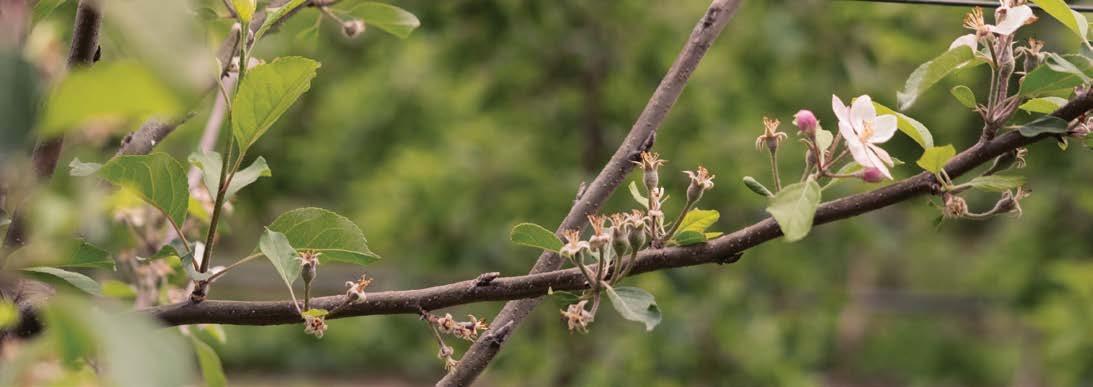
What is the role of technology to help growers navigate climate change?
“These are decisive times for growers. Cyclone Gabrielle and El Niño’s erratic weather, changing precipitation patterns, and rising temperatures threaten the very heart of our industry. It’s a challenge that underscores the resilience and ingenuity of our growers but also highlights the critical role of technology. Our ability to adapt and thrive in the face of environmental uncertainty will be largely dependent on our willingness to embrace and invest in innovative solutions. It requires foresight, collaboration, and a commitment to sustainability that will not only safeguard our industry but also ensure its growth and prosperity.”
Which innovations do you see having the most benefit for growers?
“Solutions range from precision horticultural practices to advanced weather forecasting models. The adoption of water-efficient irrigation systems and monitoring technology developed by companies like Croptide here in Hawke’s Bay for instance, can help mitigate the impacts of water restrictions placed on growers, ensuring that even in the driest conditions, our orchards can thrive. Moreover, the integration of data analytics and artificial intelligence into our orchard practices allows for a level of precision and understanding previously unattainable. These technologies can predict crop stress before it becomes visible, providing a window of opportunity for intervention that can be the difference between a plentiful harvest and a devastating loss.”
What is holding back growers from taking the journey towards full adaptation?
“Advanced technology and automation of tractors and sprayers can be costly for smaller operations, and there is a steep learning curve associated with maximising the benefits. It is crucial that we foster a community of knowledge sharing and support. Someone who does this very well is Mike Casey from New Zealand Zero. Mike actively shares through social platforms how he embraces technology, which is appealing for his customers and attracting staff who want to work for him, and they are lining up to do just that.”
Connect with Callum Ross on LinkedIn or email: manager@hbfa.co.nz
Callum Ross, Hawke’s Bay Fruitgrowers’ Association chief executive
The ORCHARDIST : MARCH 2024 61 FINAL PICK
Photo by Florence Charvin

Stronger by working together
Horticulture New Zealand works to create an enduring environment where growers thrive.
Find out about our upcoming levy referendum in the commodity levy section of our website hortnz.co.nz – vote to grow together.













































































 Rachel Depree –Zespri executive officer sustainability
Rachel Depree –Zespri executive officer sustainability



































 Biologist Revel Drummond is currently on secondment to advise the Prime Minister’s chief science advisor.
Biologist Revel Drummond is currently on secondment to advise the Prime Minister’s chief science advisor.









 Shannon Selwyn spraying blueberries, one of Wamarama’s two core crops
Shannon Selwyn spraying blueberries, one of Wamarama’s two core crops



 A trial chilli crop destined for Kaitaia Fire sauce
A trial chilli crop destined for Kaitaia Fire sauce







































